The Kitchen
For three days we stuck it out in the little blue tent. Rain drummed on the large tent fly, as the easterly marched in from the Pacific Ocean. If it’s not raining, it is about to – an easterly weather system is the bane of the sika hunter. In the meantime, heavy mist wraps around everything, soaking sleeping bags to socks, with nothing spared. Great, dark blankets of cloud blot out the sun, turning the landscape grey.
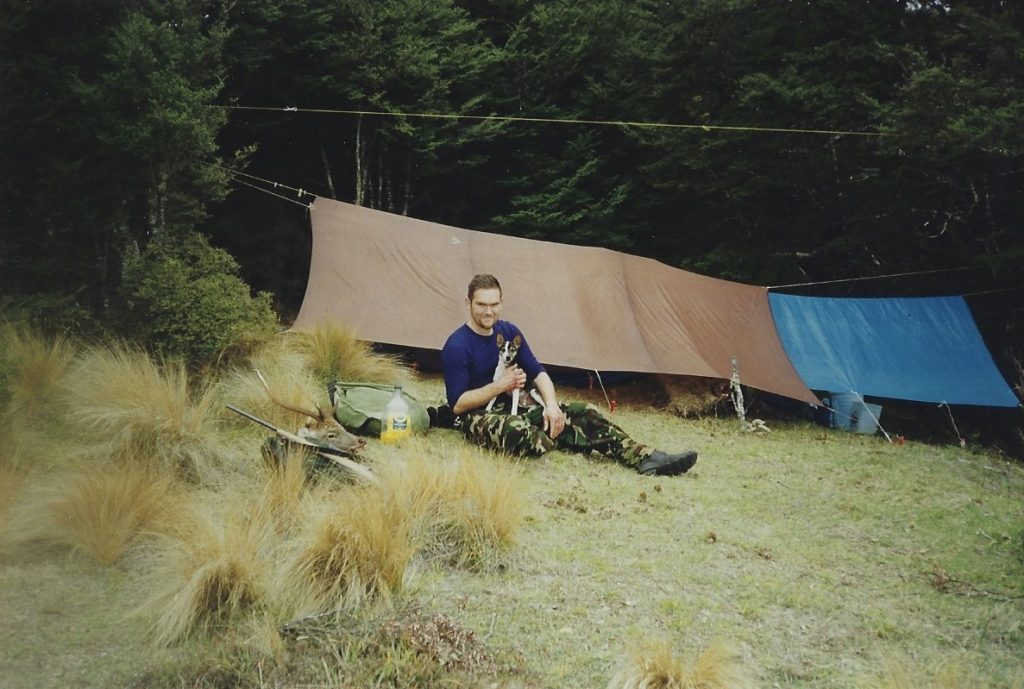
It was about the third day of cooking on damp ground that a giant cog turned over in my soggy head, providing enough power to the brain to spark an idea! Why couldn’t we build a simple little structure from beech poles wrapped in tarpaulin? That way, we could stand up and cook! “Bloody simple!” A stand-up kitchen to make these trips a little more enjoyable when the weather turns average.
The idea continued to fester away the next day while I quietly stalked through the dripping beech forest. The morning sun finally broke through – surely there must be a deer desperate to enjoy these perfect conditions? I slowly worked my way downhill, quiet as a mouse, on the damp moss underfoot. It was around 9am that the roar of Emma’s unsuppressed 243 bought me back to my senses.
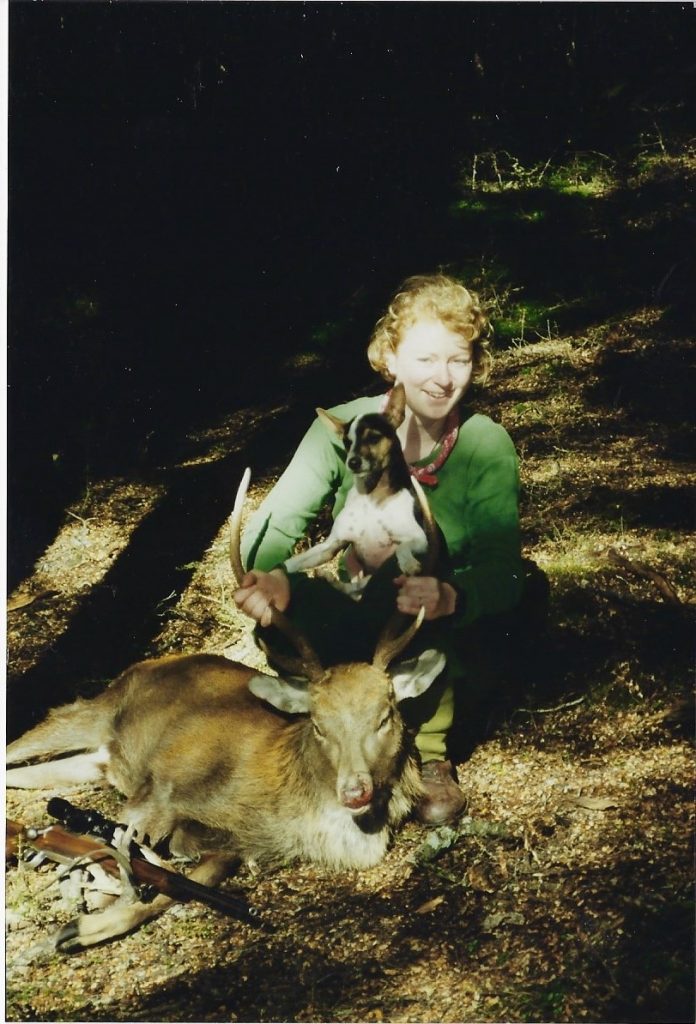
The single rifle shot that boomed out from the gullies below camp, was followed by silence. Buck and I abandoned our hunt to go and see what ‘Little Red’ was shooting at. We crossed a couple of guts and a creek before the dog raced ahead. We found our girl stripped down to her bra and up to her armpits in animal guts, dragging out intestines and all the other bits from a nice, healthy looking sika stag.
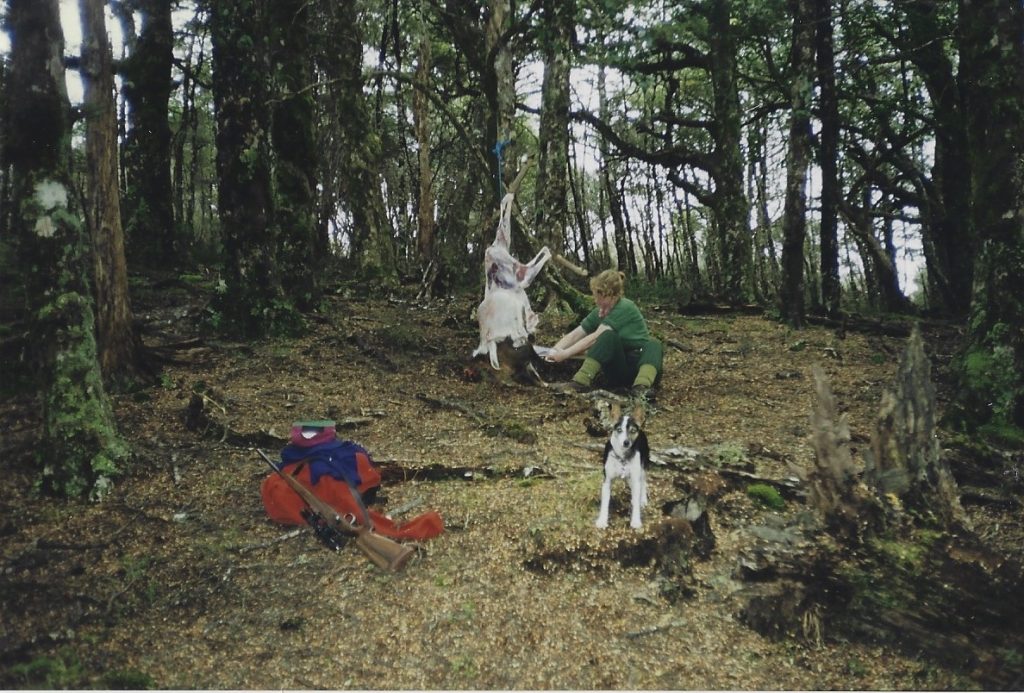
The beaming smile confirmed she was in her happy place!
“What are you doing half-naked?” I asked. The reply was, “I don’t want to get my shirt messy.” Girls sure think differently to guys.
The Roar of 1998 was a major evolution in Little Reds hunting journey. She had now broken the shackles, successfully stalking and harvesting her own stag. A collective shudder went through the sika stags of the central north island, as Little Red was about to be unleashed upon them.
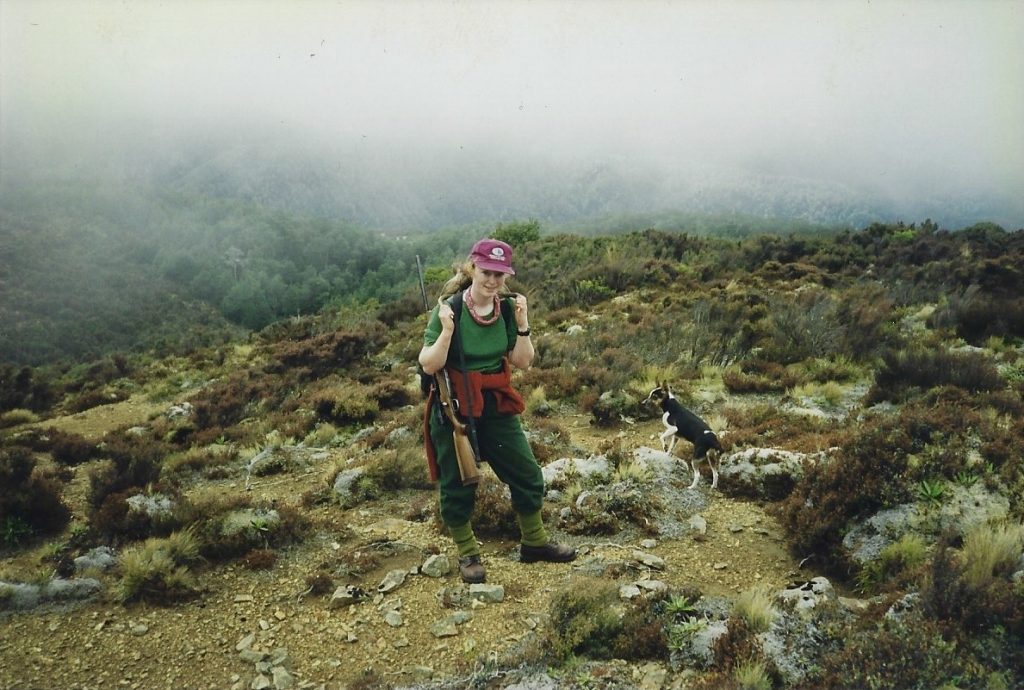
I pencilled in December to get back to camp and start work on our kitchen. The long, warm summer days would be perfect to start construction. I filled my pack with supplies, and with Buck by my side, we left the truck for the tramp in. Three hours later we had the tent back up, and with a cup of tea in hand, we poked around under the beech canopy. Things felt right in here, shelter from the wind, proximity to the creek, with an endless supply of wood for building materials.
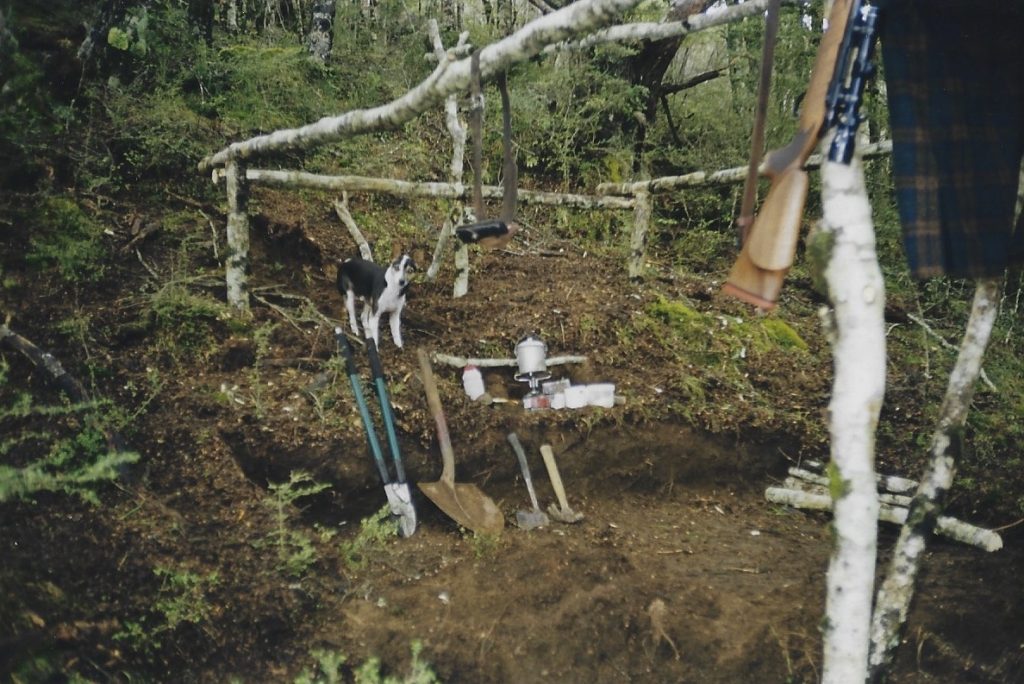
Over a second cup of tea and a biscuit, the dog and I had a site meeting, because two heads are better than one. Buck pointed out two major problems. Firstly, there wasn’t a flat spot and we would need to bring in a digger for earthworks. The second problem he could see was we didn’t have a builder. The butcher we had couldn’t even swing a hammer! That was our last site meeting with free biscuits, after that, he could bring his own…
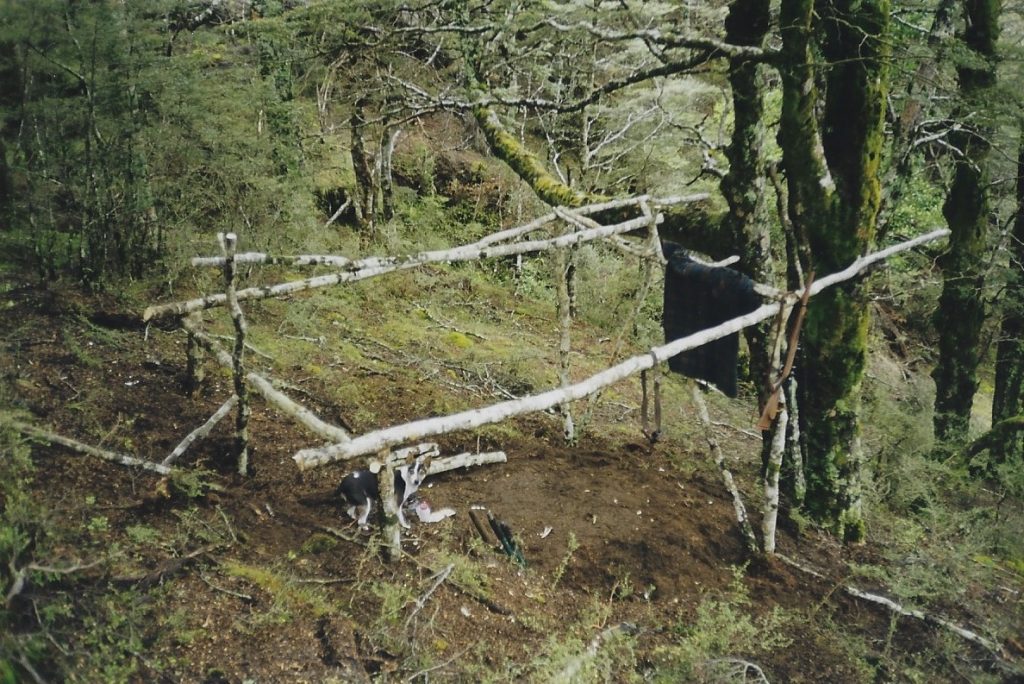
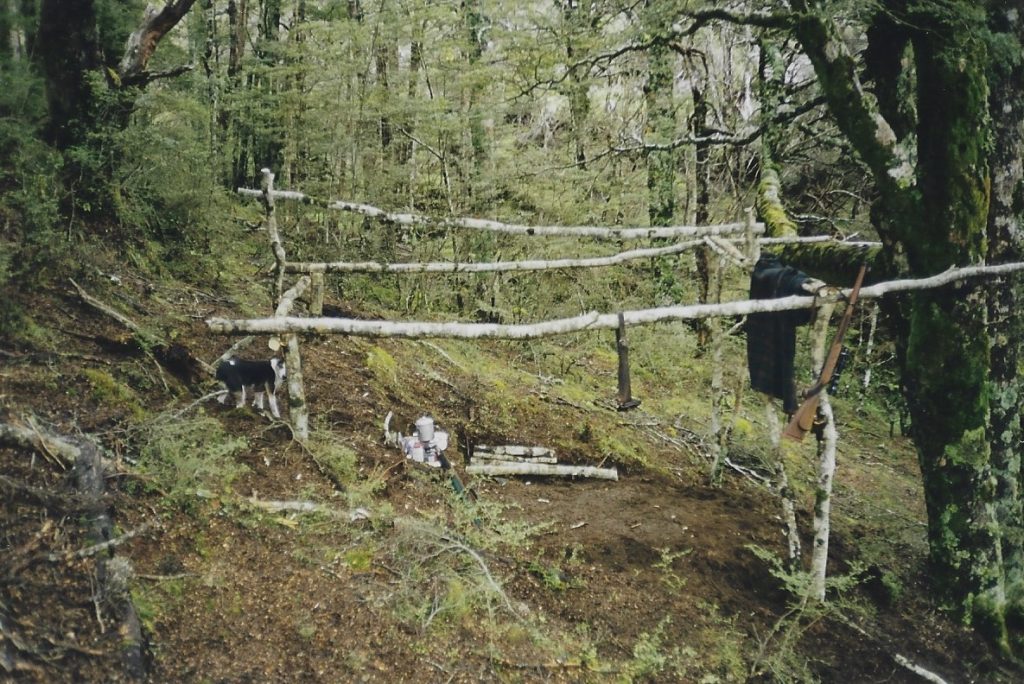
I wasn’t a builder’s bootlace and would have to wing it. I started to cut beech poles and strip them of branches. I got one hole dug and a pole rammed into the earth before the tape measure came out to start figuring shit out. As the day progressed a very basic frame went up and I retired to the tent that night a happy man. Every trip more tools, nails and building supplies were carted in on our backs during the grind in from the truck.
In January I got the ‘digger’ in and Emma shifted half a ton of dirt from the bank to improve our platform. It was now we realized we could do better than a kitchen, and could add a couple of bunks to the project. Soon enough, we would spend one of our last nights in the tent. Shovelling away, Emma levelled out the back bunk while building up dirt at the front, that we successfully held with a small retaining wall. We compacted it all down to level off our floor, while I continued to add bracing to the walls.
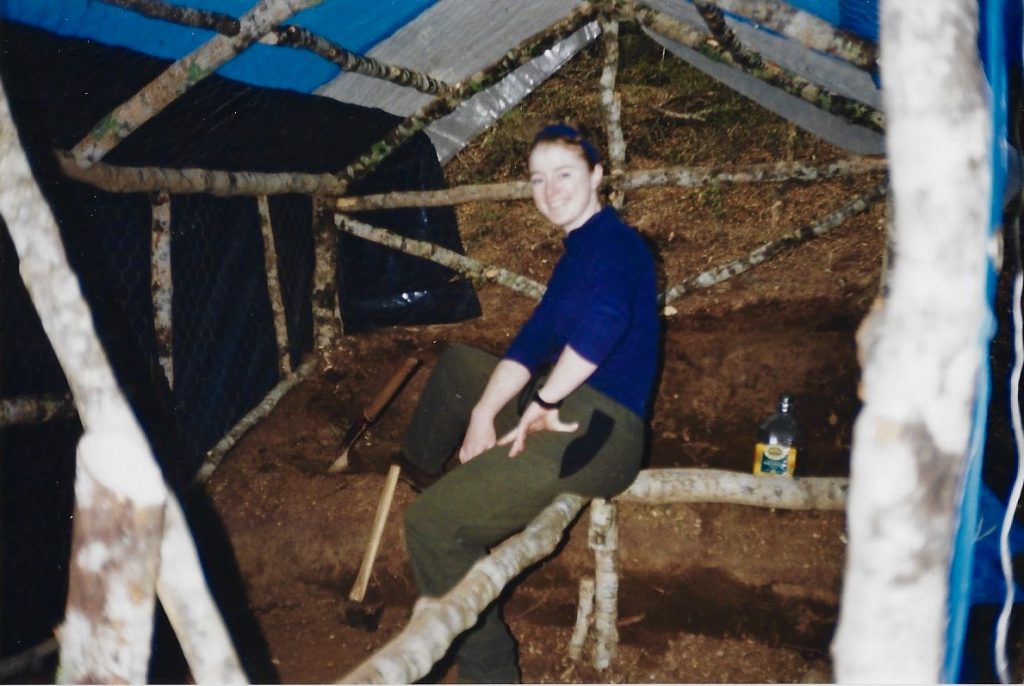
In the evenings we could still wander off for a hunt not far from camp to harvest meat for home. Emma now had her own foxy pup, called Maxine. (From Latin meaning, “greatest”). Bred on the family farm, she proved to be as hard as nails and soon joined us on many of our adventures.
Buck fully disgraced himself that evening, sneaking off while I wasn’t watching and chasing a sika down into the bush! I could hear his barks getting further away as he trailed the deer, before one of those strange things happened… for some reason, the deer turned around and started coming back up the hill.
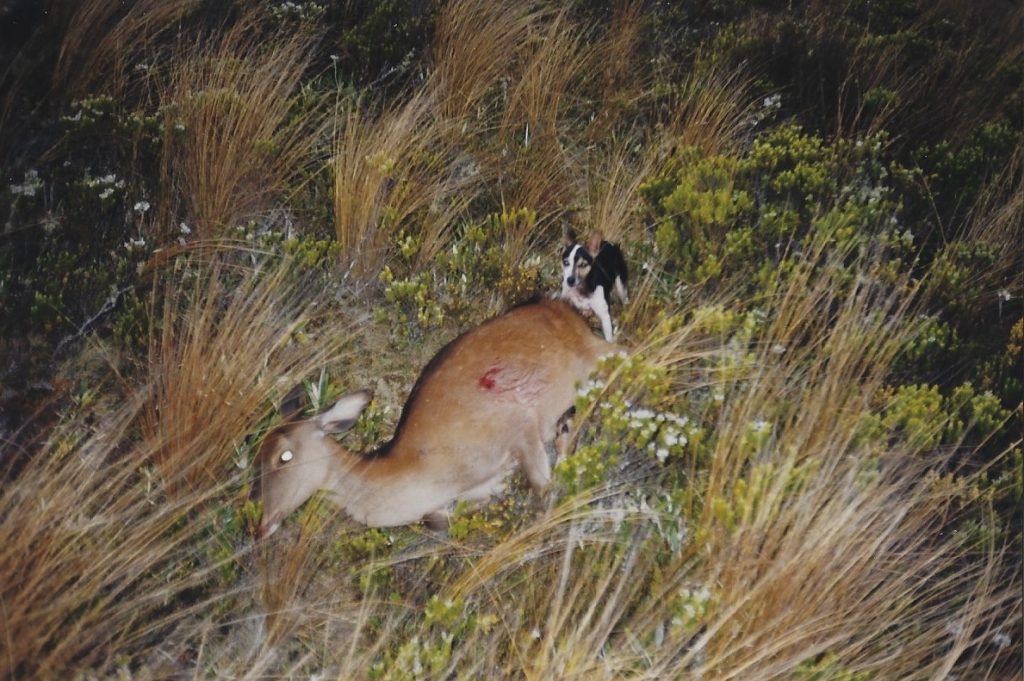
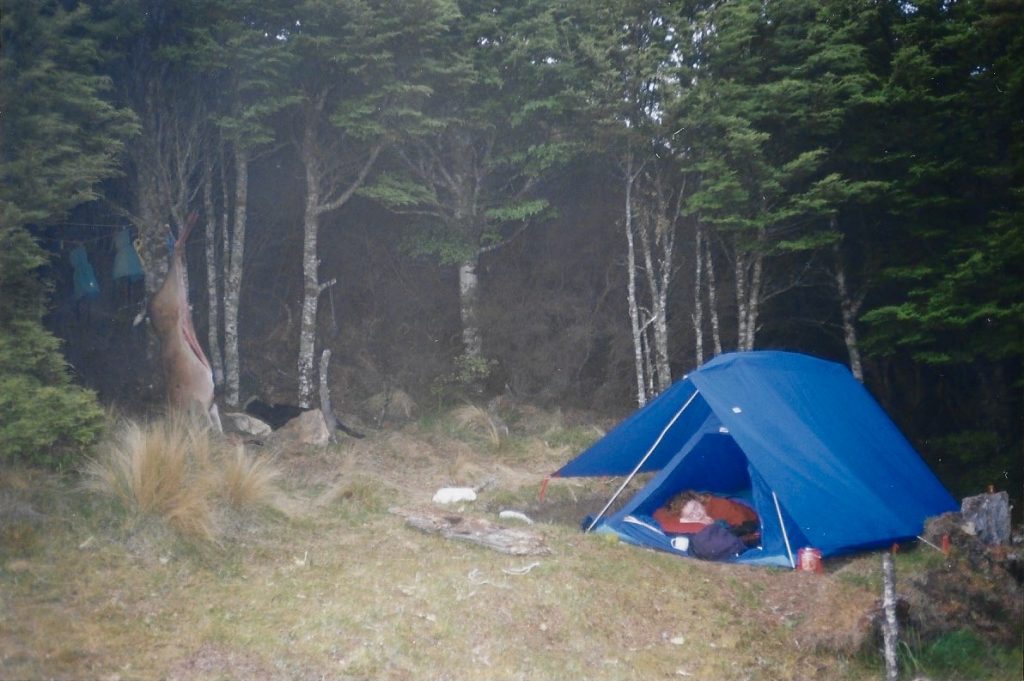
We could hear the barks getting closer! I loaded the rifle and, blow me down, a minute or two later a sika hind exploded from the beech line into the tussock below me. She kept looking back for the annoying little dog, trailing and barking about two hundred yards back.
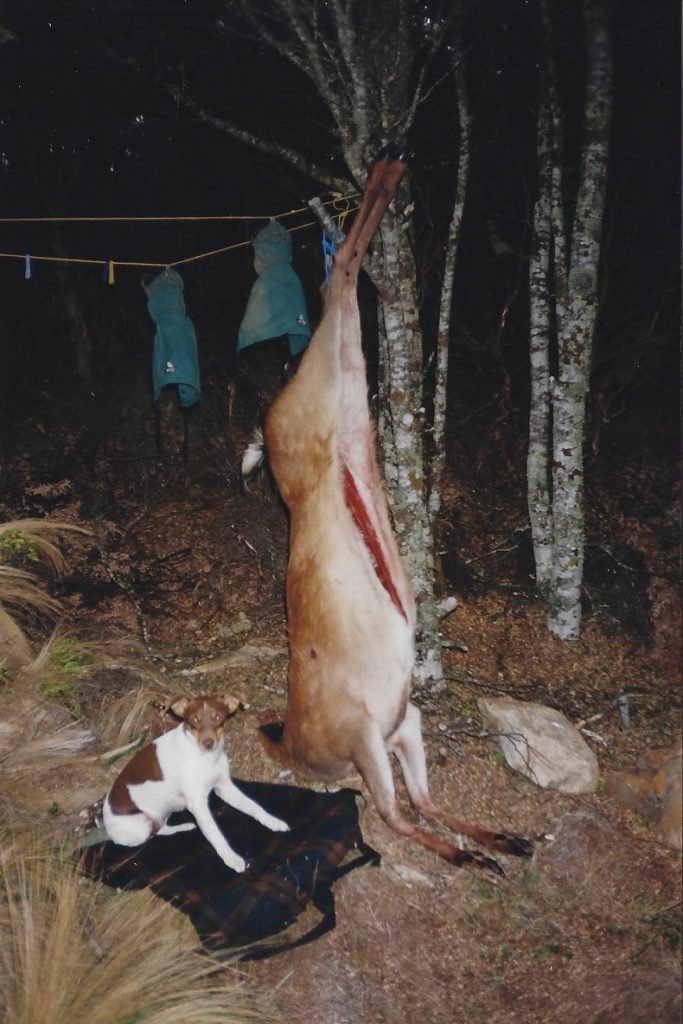
I dispatched the easiest deer I had shot for a long time, and waited for the puffing dog to turn up. I carried this one back to the camp whole – Maxine didn’t know what to make of the first dead deer she had seen.
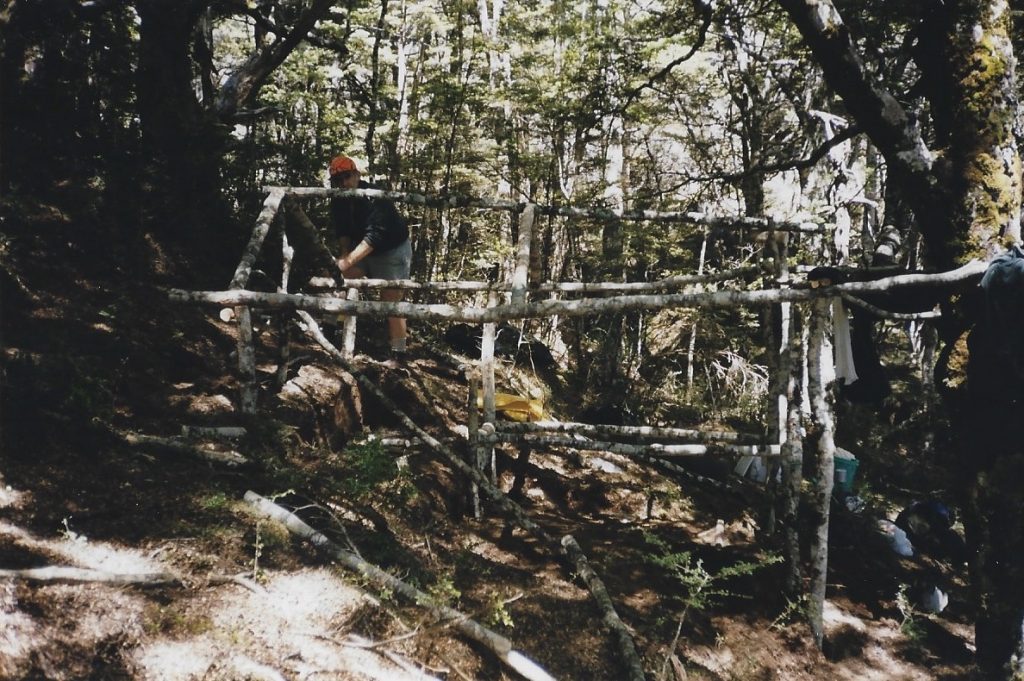
Uncle Blue turned up one Saturday morning for a council inspection, and, I suspect a roof shout. I think the roof nearly floored him, as he stood back rolling a smoke and not saying much. Shaking his head he finally muttered a few words about bloody butchers and grabbed my hammer, before proceeding to pull my not so flash roof off.
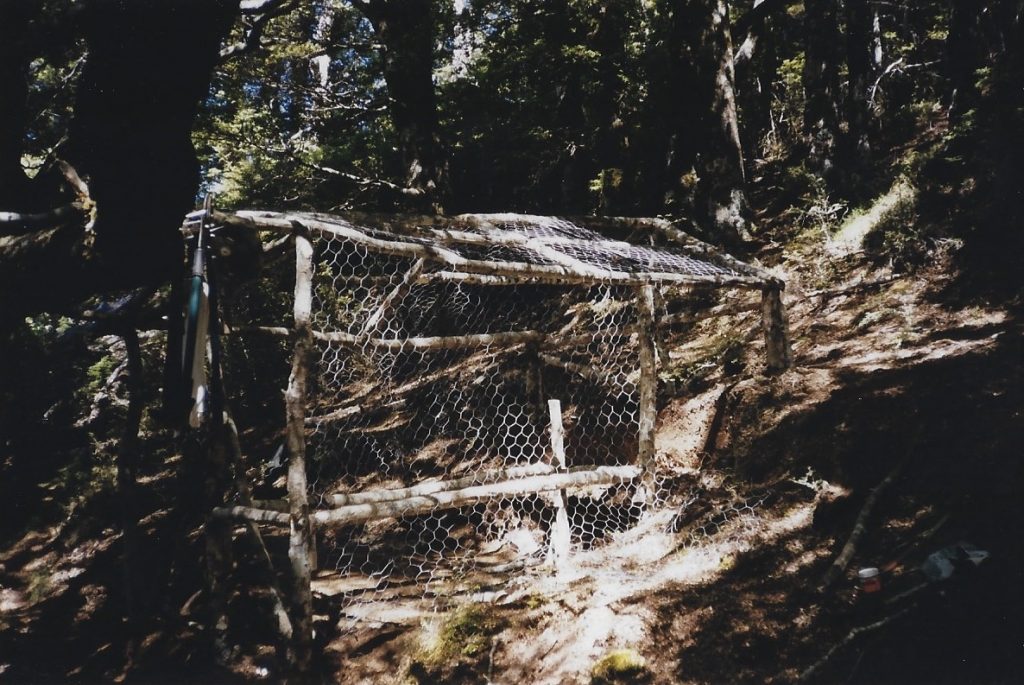
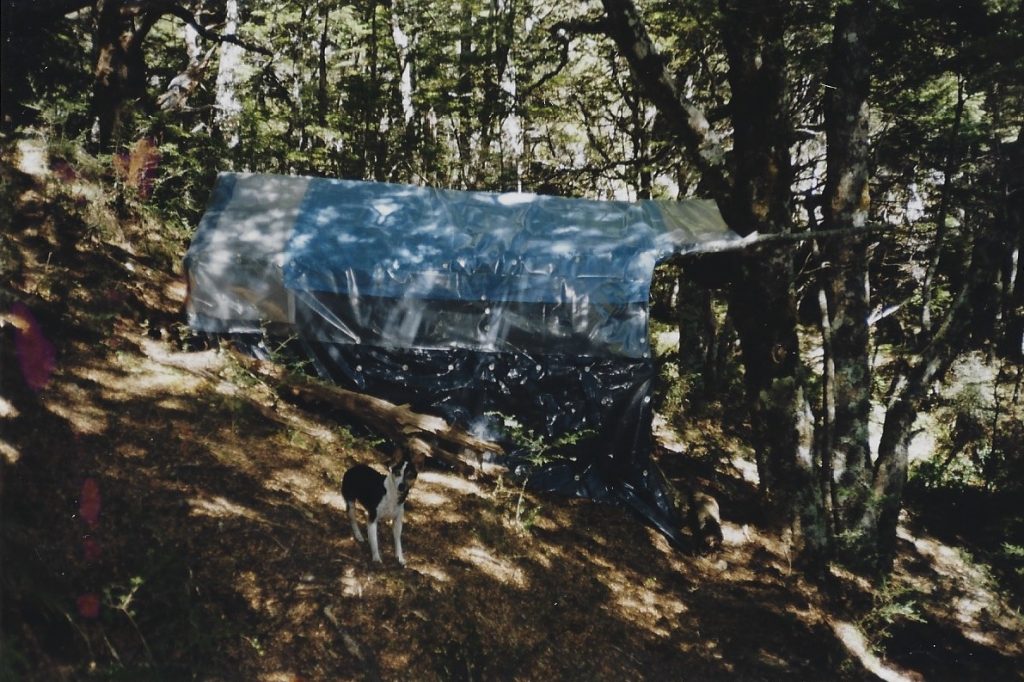
The rest of the day was spent cutting & measuring fresh lengths of beech pole for the trusses which he carefully notched together. Watching a real craftsman at work was amazing and soon enough, after a full day of hammering, the construction was complete. We had a new roof that should withstand a heavy dump of winter snow.
The cold beer from the creek never tasted so good, as we stood back and toasted the project. Wire netting was added for extra strength and finally, in late February, the Biv was fully encased with a plastic raincoat that was nailed on with beer bottle caps to stop the nails pulling through.
In March, my Dad got enthusiastically involved with the project, building us a 35kg stand-alone wood burner from stainless steel. The whole fireplace bolted together so we were able to carry it in, in small parts at a time.
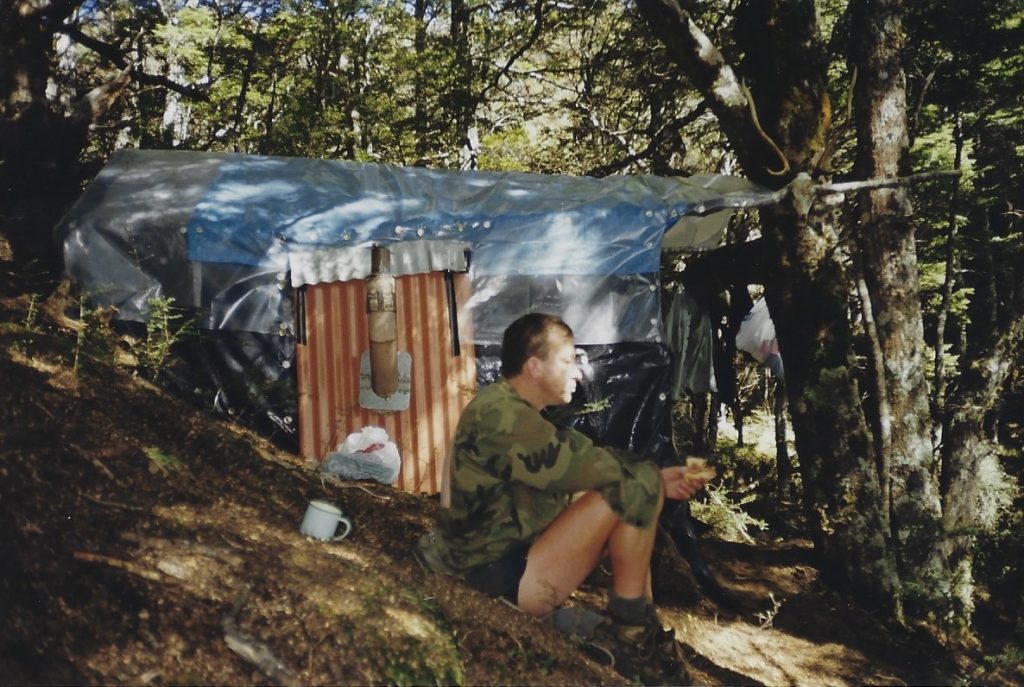
The Gotman stepped up in April, carrying the main wood burner for a gruelling five hours, while we also brought in the chimney, and a sheet of corrugated iron to stop the outside wall from melting and catching fire!
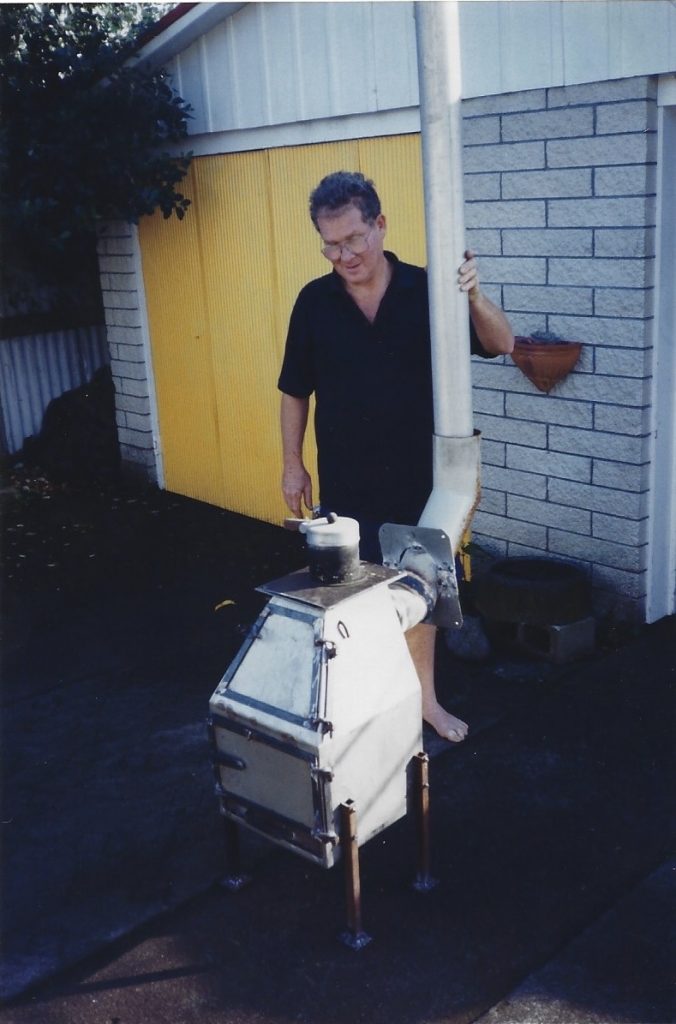
The massive step from a tent to a Biv was amazing – being able to stand up, sleep better and keep gear dry, all added up to a great experience. All the hard work was about to pay off, because in late April during the middle of the sika rut, we had our first decent snowfall!
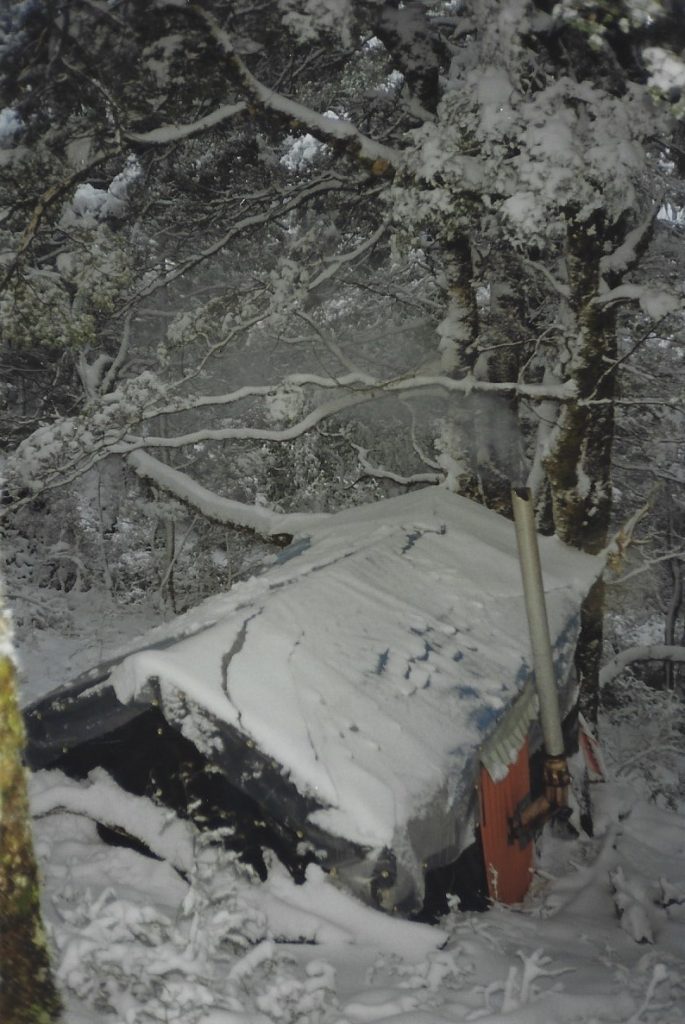
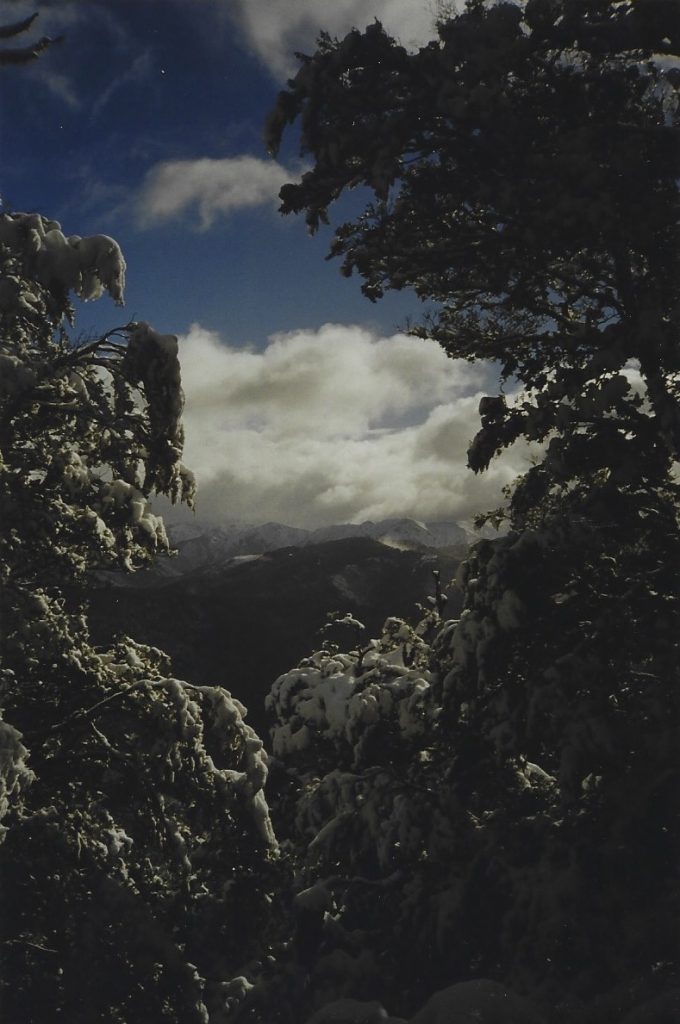
I was hut bound with the dog for 24 hours as the snowdrifts were too deep for hunting, so we just kept the coffee pot ticking over and the little fire burning. As snug as a little bug, Buck didn’t leave my sleeping bag unless driven outside for a toilet stop, or his rumbling stomach needed food.
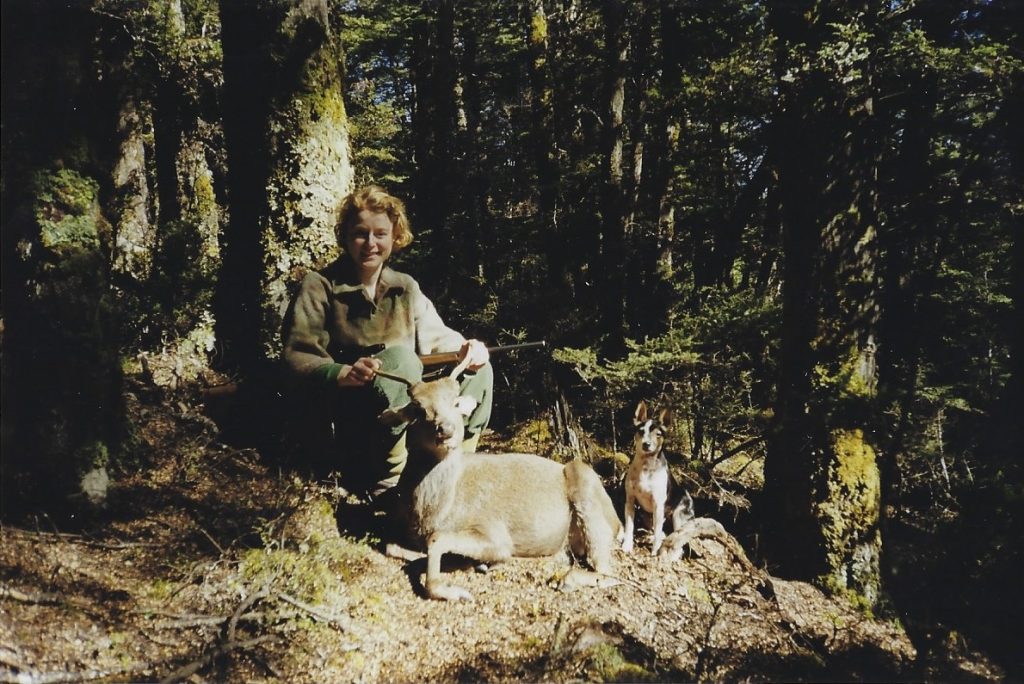
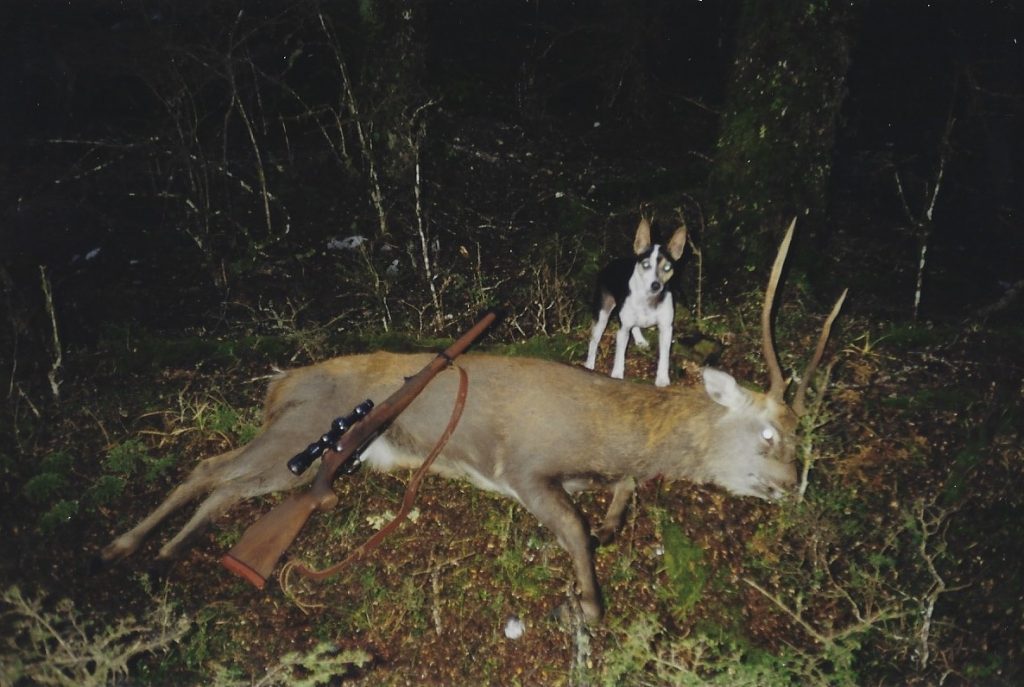
When Emma finished her shift work at the police station, and was able to join us for a couple more nights, we both scored stags while enjoying our new comforts.
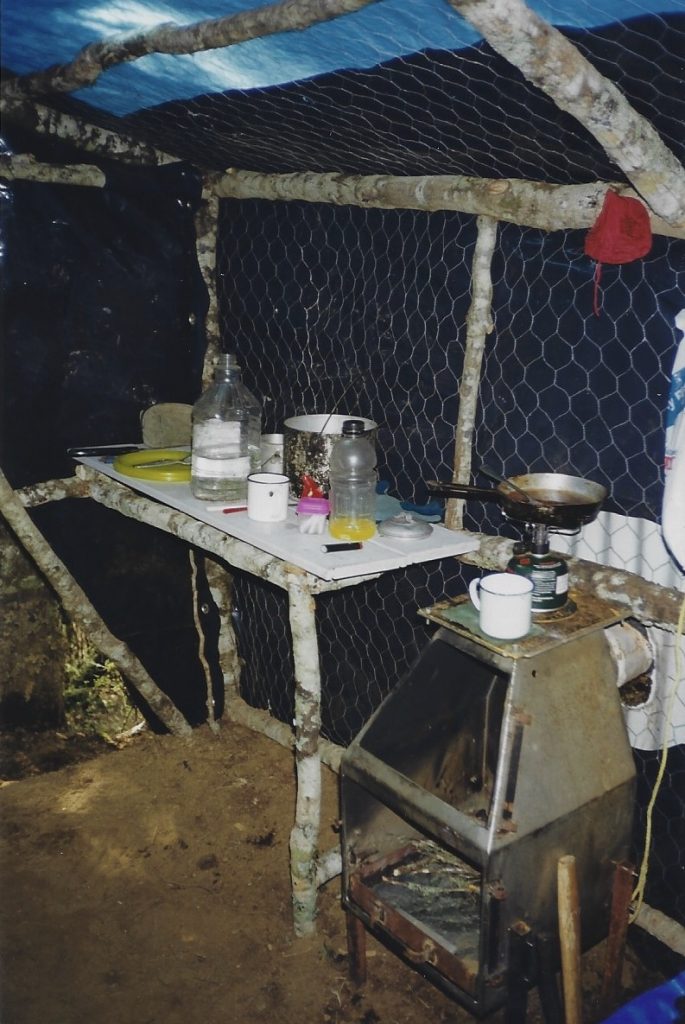
Eventually, I carried in pre-cut wooden pallets and upgraded the dirt floor, with the digs getting seriously flash as we learnt how to hunt the surrounding bush and harvest the odd deer for home.
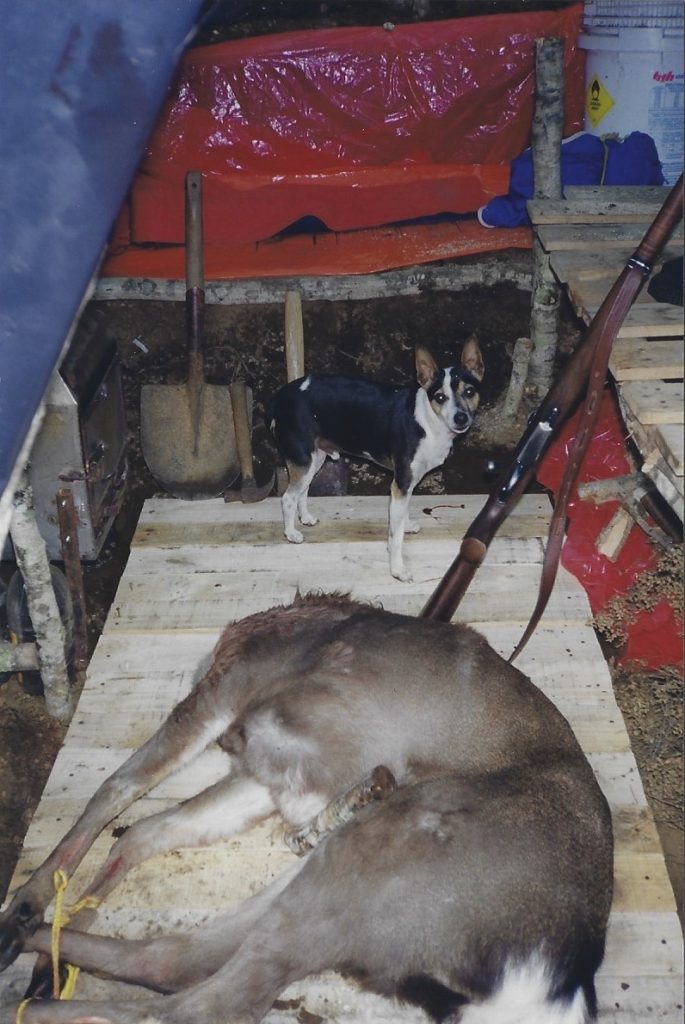
With million-dollar views into the western side of the main Kaweka range, life was seriously good for a couple of keen young sika hunters.
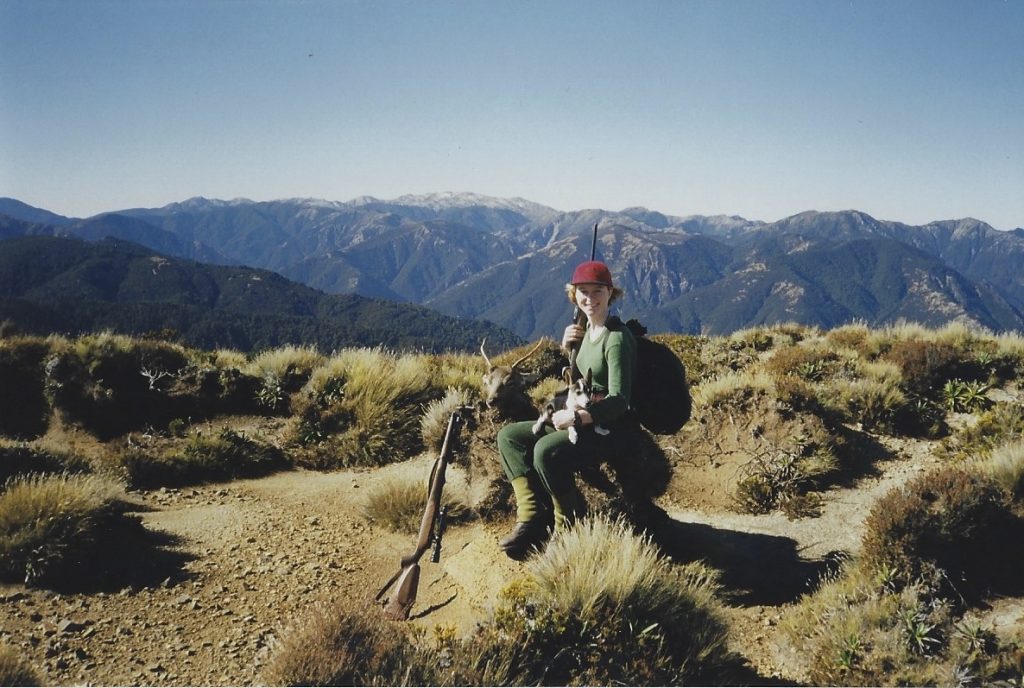
Time doesn’t stand still and we just kept rolling from one hunting adventure to the next from our happy little mountain Biv, tucked away in the back of beyond. The years seemed to pass too quickly, and soon enough there were two more little sets of boots marching over the tops to squeeze into our lodgings.
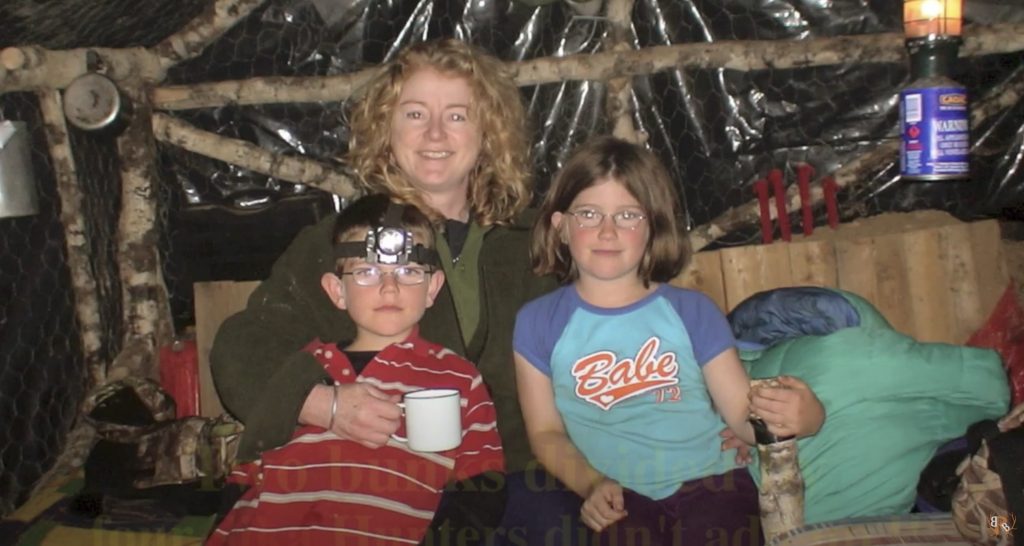
First Isabella joined us, followed by Jonty…twelve years on since we started the kitchen, soon it would be time for an upgrade!
BRB
Going South (by K. Frankum)
I opened one eye, the other eyelid was a bit sticky with dried blood. I had to rub it first, but something had brushed against my leg… a weka, with another weka behind it. The second one must have been a male, he had that downbeat, nagged look.
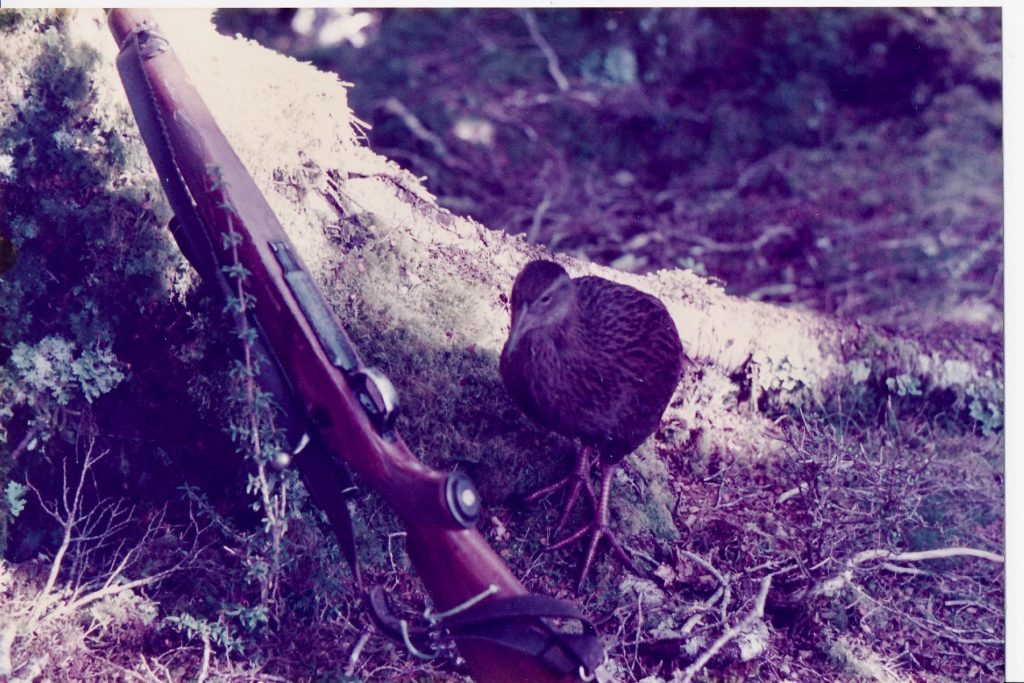
It was daylight and it wasn’t raining.That was good. My bottom lip felt like Huw Richards after Buck Shelford dealt to him in ‘87. My tinfoil survival blanket was in shreds, and that wasn’t good. But the 12 point wap/cross head lying on the ground made everything all good.
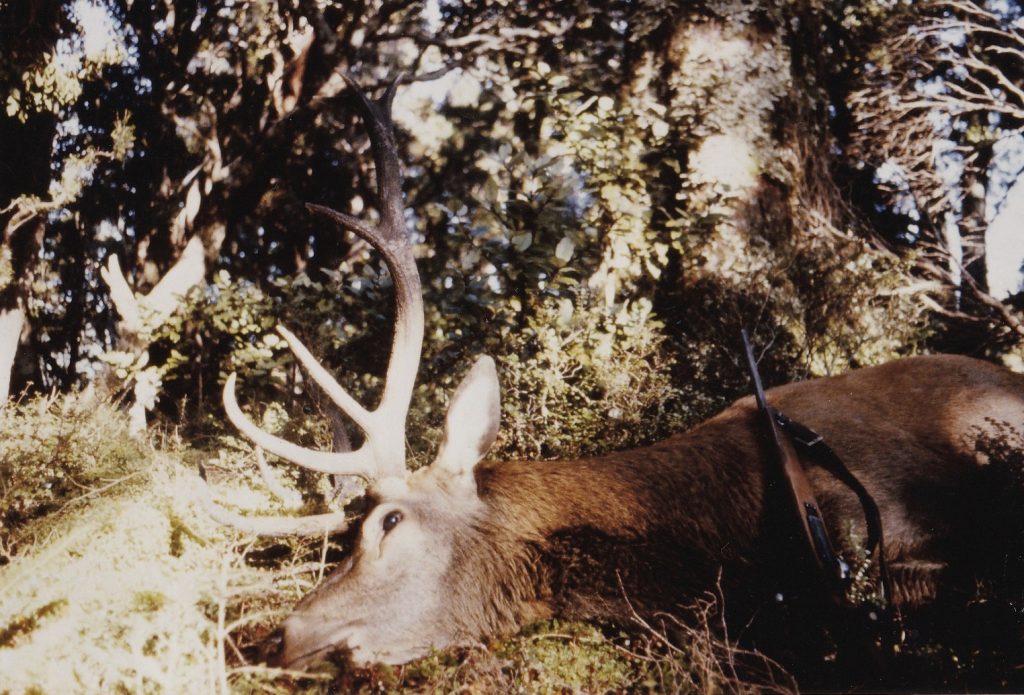
Now what was it with these damn wekas? The penny dropped – the half hollow log I was sleeping in was their home, no wonder they were pissed off! I politely asked them to go away, and wriggled out of my log. But I’m getting ahead of myself…
Well, it all started when we got a letter telling us we had the Mount Tanilba Wapiti Block. Forty years ago emails weren’t a thing, social media was non-existent and Silicon Valley was the gap between Dolly Parton’s tits, (oops, enough of that, sorry BRB).
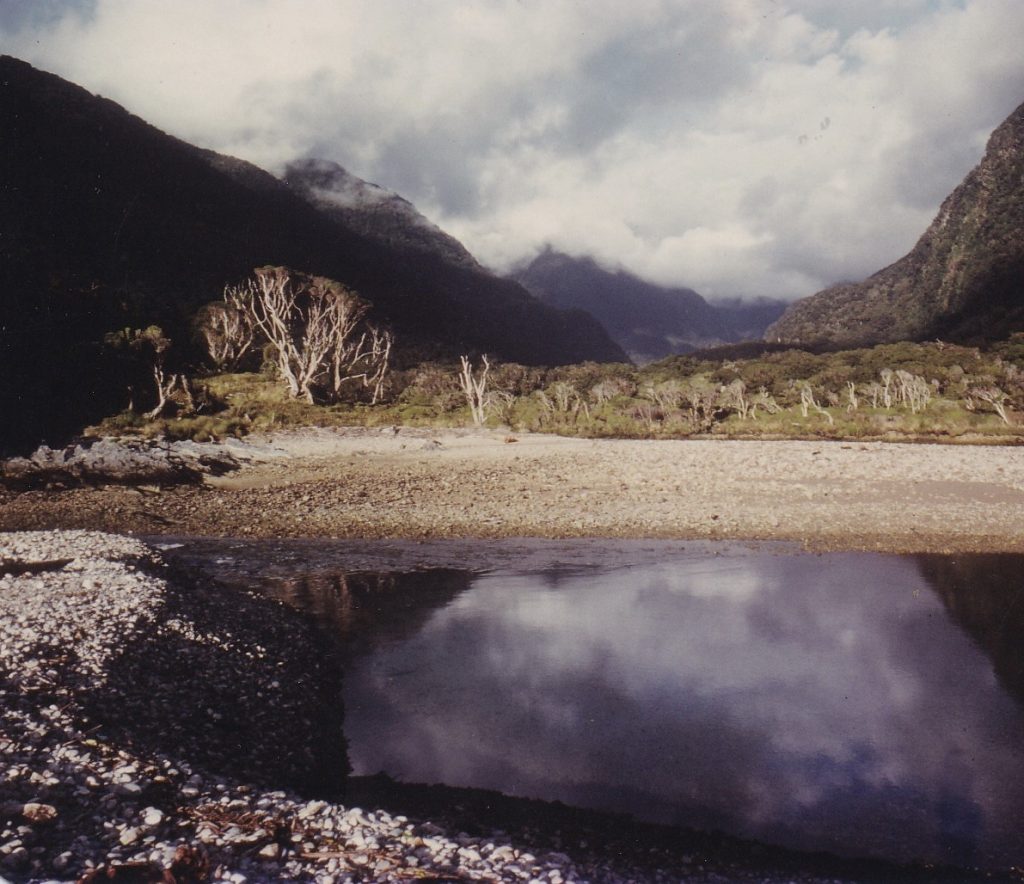
So my good mate, Brian and I were driving south (road trips are always better than flying). We had caught an early ferry and were about 30 kilometres before Murchison, going past the Gowanbridge turn off to Lake Rotoroa. It was one of those drab autumn days, on the coast, cold and about to rain. It had just stopped raining, but I was thinking it would start again soon. We were past in a flash but there was a glimpse of a hitchhiker, who looked like a tramper. I thought, should we, should we, hmmm maybe? Bugger it, poor basket, he looked a bit bedraggled, so we turned around…
Well, he was a young German guy, about our age, all sorts of flash kit, Lederhosen poly props, Bavarian marching boots, flash pack, a walking pole… bugger me. And I thought my Japara sleeping bag cover was the go.
We got chatting. He was going to Greymouth, that was good, we were going to Hokitika.
He had been over the Travers Saddle, down to Lake Rotoroa, and had got a lift to the Gowanbridge junction on the back of a cocky’s ute. He’d been waiting for a lift for two hours.
Brian said, “Hear any roaring, you know, stags?”
Well, he had heard all right. All night he had heard these angry beasts, “Gott in Himmel, ” he muttered, “snorting and coughing and roaring.” I told him he was lucky it was night time, asking had he not seen the warnings from the Tourism Board? He hadn’t – “oh dear,” said Brian.
We explained that the deer around Murchison had evolved into omnivores, due to the lack of magnesium. Gunther got the gist… they had been known to prey on solo trampers. At night he was safe, as they spent all night mating and roaring, then they slept till lunchtime. After that they got hungry, and wandered around in mobs, looking for a feed. That caused another, “Gott in Himmel,” with a couple of “Achtungs” thrown in. It was like those war comics I used to read when I was six.
It started to rain. One of us suggested, probably Brian, that if we gave him a lift to Greymouth, how about he shouts a couple of pies and beers at the Murchison Pub for lunch? Well before you could say, “we sunk the Bismark”, he was in the wagon and we were off. We did explain we had pulled his leg, but I’m not sure he trusted us after that. We dropped Gunther off, on the best of terms, in Greymouth, after buying him a couple of beers in Reefton, international relations preserved.
Next stop was Hokitika.
The day was drawing on, so we paid for a basic cabin at the motor camp, scoffed a burger each, then picked up a box of beers and headed out a few kilometres to see Ray Tinsley. At that time he was probably one of the most active wapiti hunters of his generation, and had just published a book, “Call of the Wapiti.” (Highly recommended, along with its sister book, “Call of the Moose.” I had phoned him the week before, and we had an invite. For two green, young hunters, it was like visiting royalty.
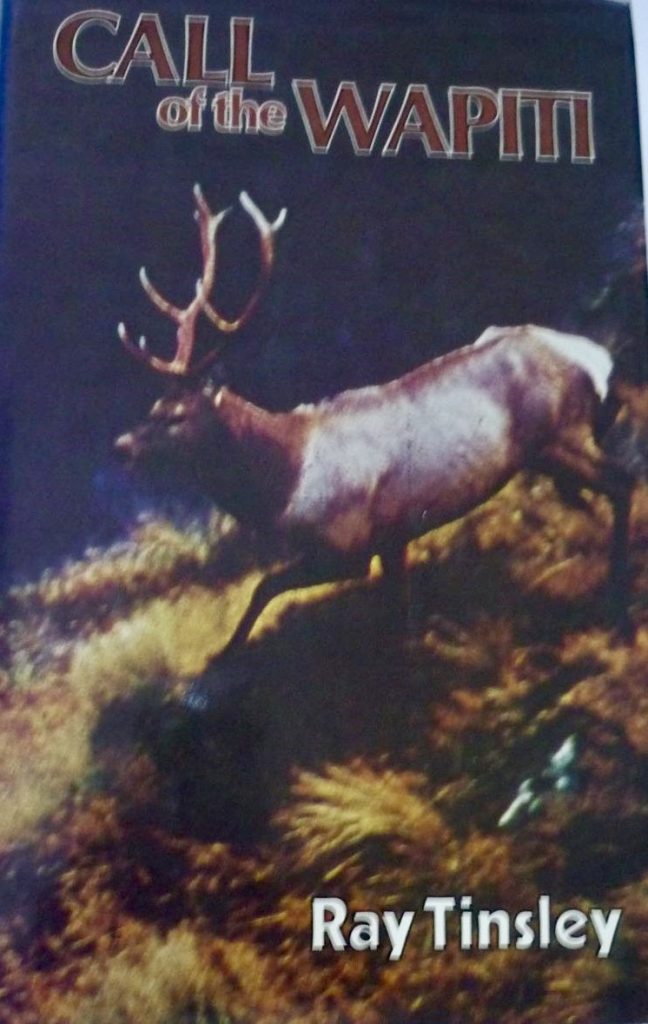
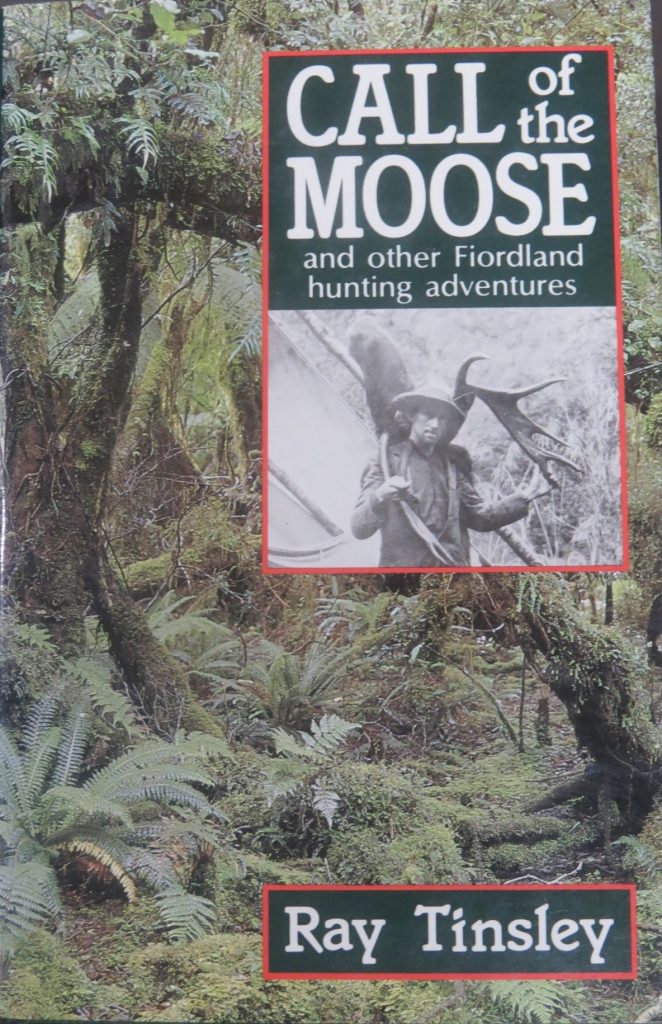
Ray was great, so laid back, gave us lots of advice, and showed us his trophies. The bit of advice I will never forget was, “Back yourself. If you see that trophy bull across the valley, or over the hill in the next watershed, go for it! As long as you have survival gear, and the weather doesn’t turn, you can survive for at least two or three days. “You may never get another crack at him.” Top man, Ray Tinsley.
The next night found us in Te Anau. After a long day on the road, the first job was to catch up with our ride. Terry had a cray boat. Myself, along with three other Hawkes Bay hunters, had met him the year before. Another top South Islander.
The plan was we would meet him at Milford, at 7 am the next day. The weather forecast was primo, our gear was packed, and my Japara sleeping bag cover had a fresh spray of waterproofing. What more could a young hunter want?
By 10 am, we were heading out of Milford Sound, turning left and heading down the Coast.
Terry and his mate got a big frying pan going, we all feasted on bacon and eggs, baked beans, and toast. The sea conditions were great, just a big lazy swell. Poison Bay, Sutherland Sound, Bligh Sound, George Sound, Looking Glass… they all slipped past. We dropped and lifted a few pots around the mouth of George Sound. Huge rock faces, hanging valleys, with the ranges turning blue in the distance in the late afternoon sun.
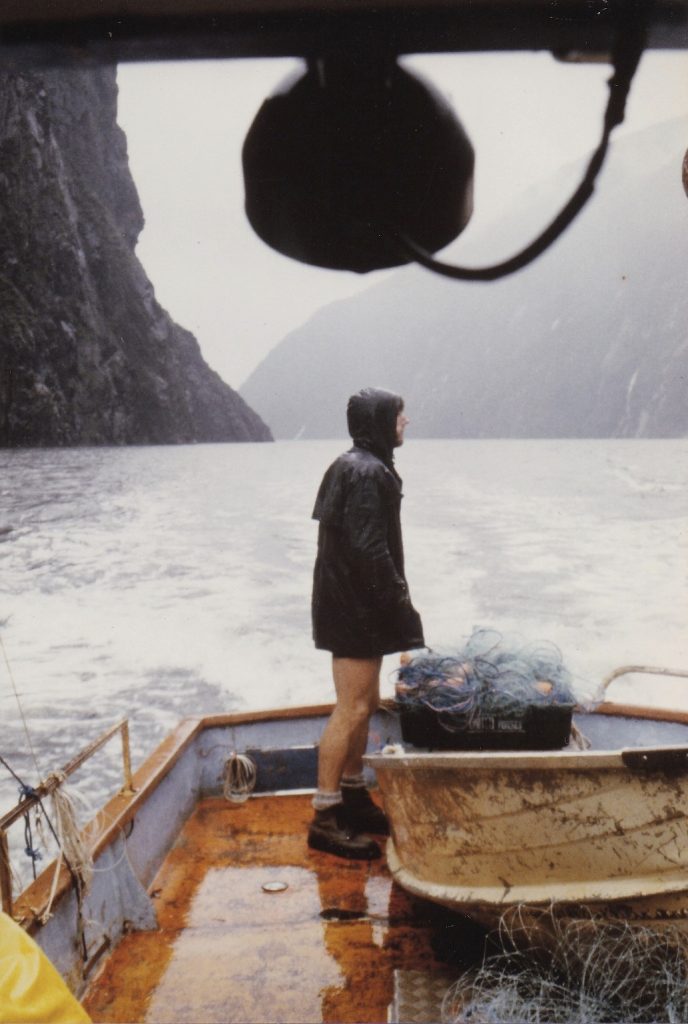
Two Thumb Bay is an exposed little cove. It faces due west, but today we had no issues with landing, sitting on our packs whilst Burt rowed us to the beach. Terry had given us a dirty, white towel. “Tie this to a stick.” They were working their pots between Charles and George Sound this week, they would be cruising past every day, going one way or the other. “If you get into strife, do what the Italian Navy does every time it sees a ship it doesn’t recognize – wave the White Flag!”
“We will call in, and pick you up at low tide, 2 pm, in 8 days.” This was reassuring, as we didn’t have a radio, and emergency locator beacons hadn’t been invented.
Five minutes later, the Okarito disappeared around the headland and it was quiet. Our camp was forty metres behind the beach. I stayed there last year. An old shirt was still tied to a tree, half a kero tin was sitting by the rock fireplace we had made, and a wee brook bubbled or babbled thirty metres away, so it was like coming home.
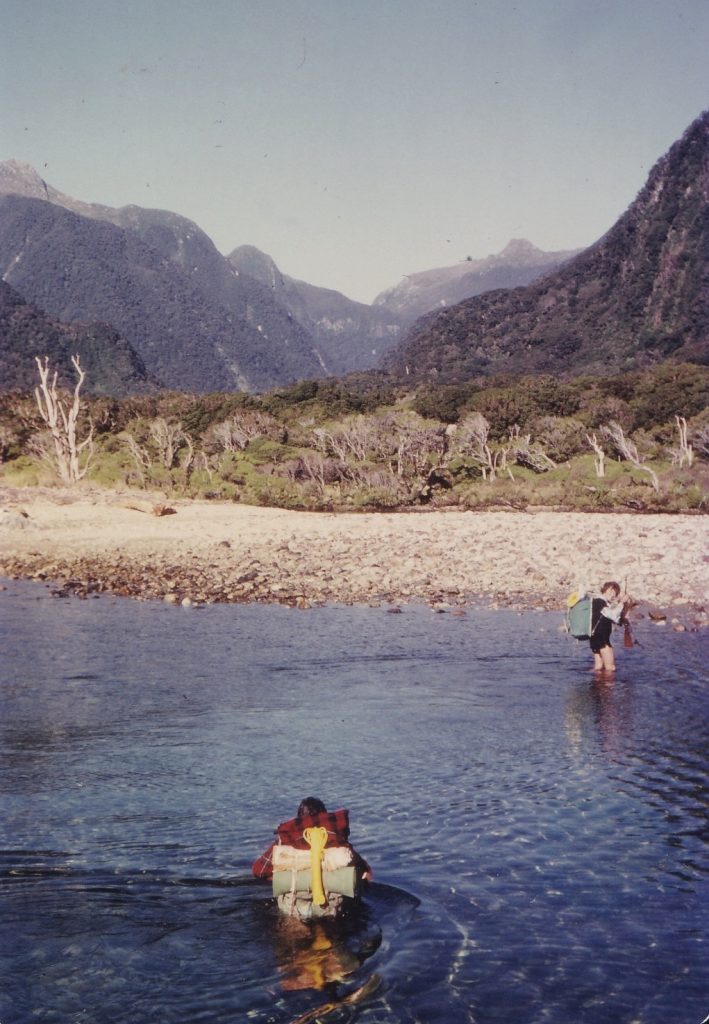
We only had an hour before dark, so just pitched the tent. Always have a tent with insect mesh if you are camping near the coast in Fiordland. There are sandflies in the day, and big fat mosquitoes at night. The wind was blowing up the valley, so it would have been stupid to light the fire, so made a hot soup on the kero primus and went for an early night. However, I was still a bit hypo, and about 11 pm was struggling to sleep, so I got up quietly and walked over the dunes to sit on a log by the high tide mark. Way up in the hills were a couple of red stags, roaring each other into a frenzy, no moon, more stars than you could count, even if you lived for 500 years. Orion, my favourite constellation, was up there, 700 light-years away. Every 20 seconds a big wave would crash, and if it wasn’t for the odd roar, I could have been sitting here 20,000 years ago…
Next day we spent all morning sorting the camp, re-pitched the tent, put a fly over it, then a bigger fly, so we had a couple of metres in front. We dug a trench around the tent with my army fold-up spade. Got in a supply of dry wood for cooking, and for boiling any heads in the kero tin. Fiordland can be a harsh mistress. Rule number one, get a good camp sorted. That afternoon, Brian went for a wander upriver. I went north around the coast, but got bluffed out after an hour. I found another old campsite, maybe undisturbed for 20 years, with just a few rusty billys in a cave, and some poles tied together to make a bunk, above the rocks.
The next day we were away at daybreak, climbing up onto the main ridge to the north of the Two Thumb River. It was another bluebird day, actually too warm. We heard no stags for the first hour. It was a steady 700m climb to the top ridge from the coast and below us was the sea, and Two Thumb Bay. If you have a look on NZ topo, you can see where our camp was, at the south end of the bay, up against the hill that climbs up to Mount Tanilba. There is a tidal lagoon where the river enters the sea. You need to cross this to head up the valley, otherwise it is a bit of a mission going round the side in the mud and swamp. At very low tide it’s about knee height, at high tide it is neck height, so the trick is to carry your pack on your head. But not at night, as from our camp we could hear splashes and gurgles. One day I found half a fish, a kahawai or a big mullet, that something had chomped. Probably a seal. Brian told me he saw a dorsal fin on the evening of the second day, but I didn’t believe him, although I did notice after that he always asked me to cross first.
Anyway, we got to the top, leaving a few markers on the way up. It wasn’t that bad, climbing up, but it’s always harder finding the route going down. On the top of the ridge was the biggest wallow I have ever seen, maybe 50m across There were a couple of stags, hanging around, but just scrubbers. Not much roaring, just the stags I had heard from the beach the night before, way across the valley.
We were travelling light, just a pikau, water bottle, survival gear, some rope, and rations for the day. We headed north along the ridge towards Looking Glass Bay. Good open bush and plenty of sign, and after about 20 minutes, we heard a hybrid roar, back off a side spur, beyond the wallow, half roar, half bugle. I thought at the time, worth a look maybe…
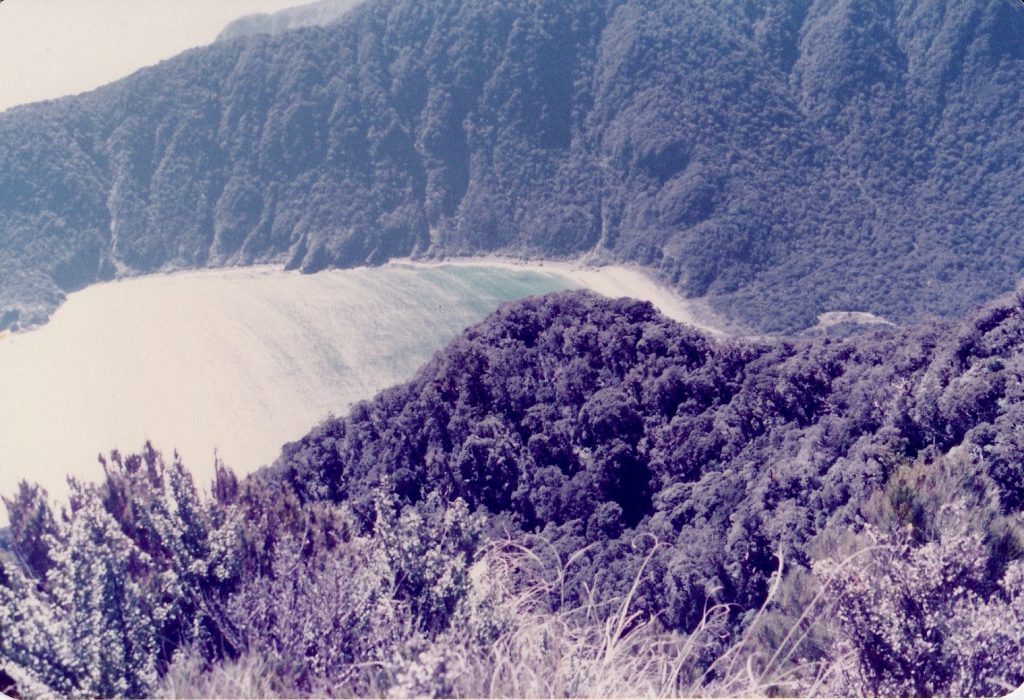
Well, we had a great day, walking and looking. At one stage we were directly above Looking Glass, while way down the coast we could see a cray boat lifting pots, near the mouth of George Sound.
We had a good look at the tops above the Whitewater, but no sign or deer trails. This was at the height of the helicopter shooting, so most of the deer had learnt to live in the bush. Anyway, we got back to the wallow, about ninety minutes before dark, feeling a bit flat, having seen nothing but the scrubbers earlier on, with only the odd, sporadic roar. We were about to pick our way down, when the hybrid stag I had heard eight hours ago, let out a roar bugle, and was answered by one of the motley red stags below us.
Brian looked at me, gave me a grin, and said, “yours!” I think I said, “toss you for it,” but he insisted. What a great mate. He gave me what tucker he had left, cheese and crackers I think, wished me luck, and high tailed it for camp, while he still had enough light to drop 700 metres and get back just on dark.So the stag was, I guessed, about 800m away, somewhere along this narrow gutted spur. The breeze was good, I checked my Ruger M77 270 – all good. Now that I was by myself, I slipped one up the spout, with a half open bolt, and gingerly started sneaking along. It was all bush, with the odd open slip, the ridge was maybe five metres wide, and dropped off very steeply to my right, 700m down to the Two Thumb River. He was roaring every few minutes, occasionally getting a reply, so I kept quiet. After a bit, I came to this log across the ridge, couldn’t go under, but I just managed to get a leg over, and slide across. Fool me, I should have remembered that log later. A bit further, and I saw a patch of brown grey, it was a big wapiti hind, such a big deep chest. Beautiful, she watched me for a few seconds, then mooched away below me. Where was that stag? Another hundred metres, no roars, had I spooked him? Surely I’ve passed him? Then, a grunt below me, 30 feet away… I could see an ear, an antler, looked ok, a neck… boom! Thank goodness a clean kill – if he had gone five metres, there was a huge bluff…

Well, it took me five minutes to get my heart rate back down. Twelve points, tops a bit weak, more red than wap, but the best I had shot. It took a bit of wrangling to drag him just a few metres to a flattish bit. I took the full head skin, (my mate, Max Motley, a taxidermist, had drummed into me always take as much head skin as you can). I stuffed a back steak into my pikau, and put the head on my back. I wrapped the head skin which was still attached to the head, around it and tied it all up with a bit of twine.
There was still a bit of sun above the horizon, but I knew if I got as far as the wallow, I would be happy with that. All went well till I got to that log. I got halfway over it, with the head on my back, when, whoomph! I ploughed face first into the mud on the other side, in a big jumble of antlers. One of the tines ended up in my mouth, and ripped out a lump of my inside lip. I bled like a pig. Fool me, I could have lost an eye.
Twenty minutes later, I was at the wallow, with the sun well over Australia by now, with just half of it above the horizon. Away below, and to my west, I could see Two Thumb Bay, and the Tasman. First I needed water.
That’s the thing about Fiordland, although it has such a high rainfall, there are very few creeks high up. I had drunk all my water earlier and was quite dehydrated. No choice but the wallow. I had a light plastic cup, so I picked a puddle that looked like it hadn’t been pissed in lately by a roaring stag, used the cup to fill my drink bottle, then used one of my socks to filter water back into the cup… it tasted great, sort of.
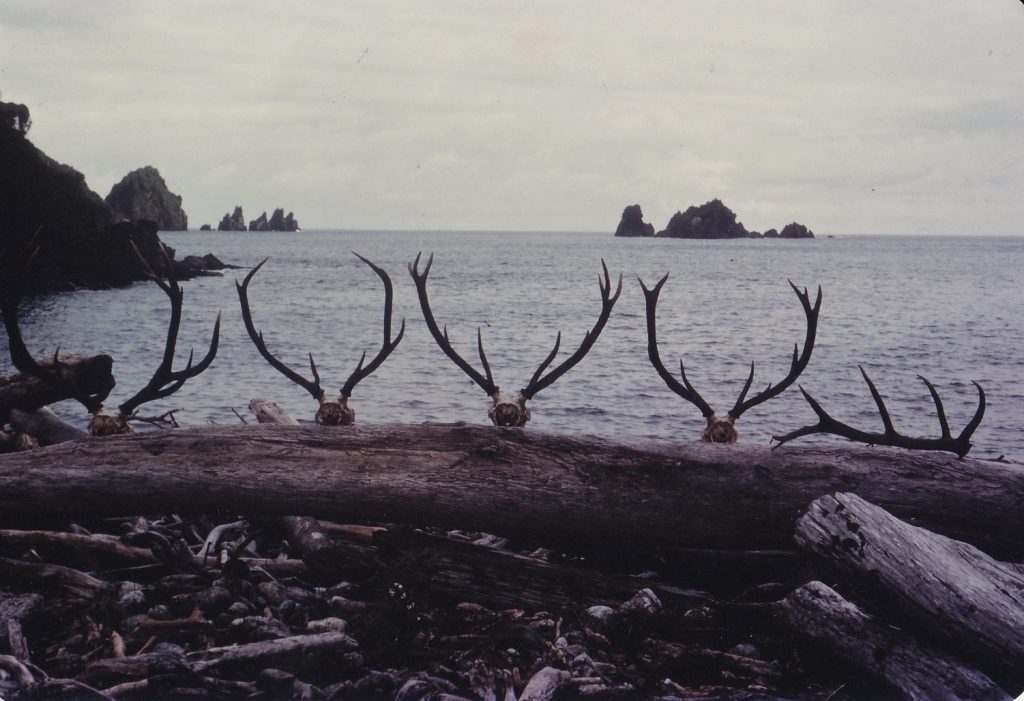
Next thing was shelter, as I was cooling down fast. I got my survival tin foil bag out, scoffed the last of the cheese, and yes, there was a log, and half hollow – a Three Star Log! Bliss. I put everything on, including a parka and wriggled in. I was still hot and sweaty, so I went to sleep quickly. About midnight, I woke, all my sweat had turned into condensation in the bag, and it was cold. I wriggled out of it and had another drink. It was a hell of a lot colder out, so I climbed back into the tin foil and into the log. I didn’t wake up until I was hassled by those wekas…
It was all pretty vanilla from then on. It took me three hours to get back to camp that morning. I needed to use the rope a few times to lower the head in front of me, but following the markers we had left, it gave me a route.
Brian had left a note, to say he had gone upstream and would be back that night. I spent all afternoon with a scalpel taking the skin off the head, being very careful with eyes and tear ducts. Then I boiled the head in the kero tin.
The day after was wet, so that was a pit day. Brian got a stag the next day, a ten pointer that I think was mostly red, but the weather was still too warm, so no roaring.
Day four, fortunately, we were at camp when Terry turned up about lunchtime. He yelled to us that he’d be back in a couple of hours, as there was a storm on the way. So after a quick pack up, we had a dodgy dinghy ride to the cray boat, and a trip to George Sound. The storm was still 36 hours away, and they had more pots to lift and store for the winter in George Sound. There were hundreds there above the high tide mark. Pots belonging to half a dozen Cray Boats.
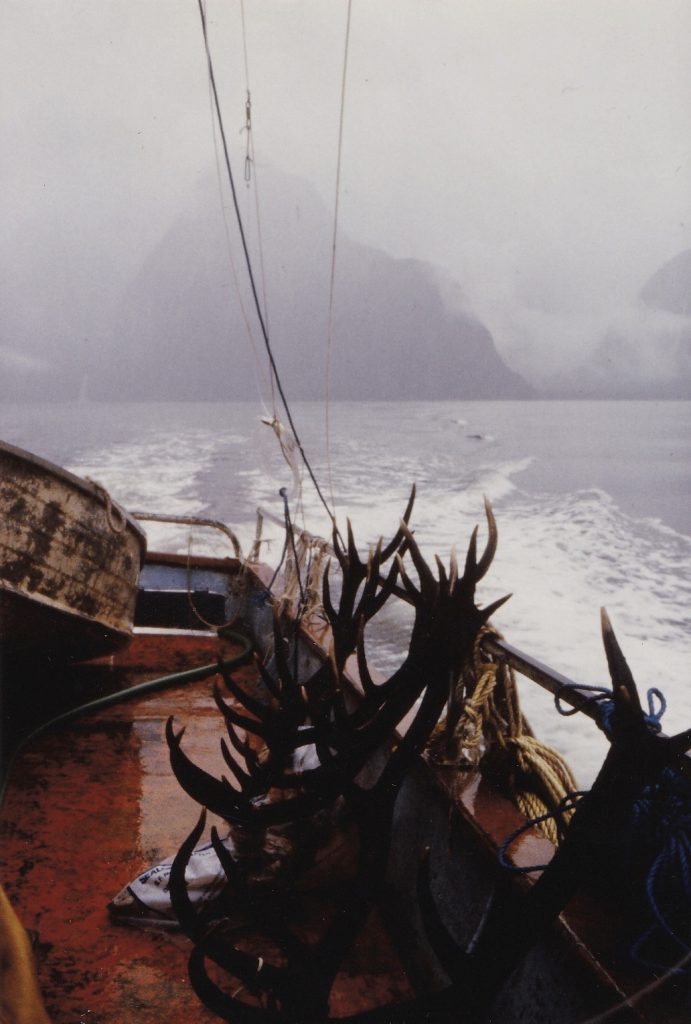
So when we got to the head of George Sound, we had an option, either the George Sound Hut, or he could drop us in the White Water. The party that had that block, had pulled out a week ago – Aussies, according to Terry. They only stayed four days, and then radioed in to get a heli out…
Well the Whitewater was a classic block, so how could we say no to that? Classic or not, all we saw in the twenty hours we were there, were footprints with a few bugles in the distance that night. But as we had a pick up at 10am the next day, we barely scratched the surface of it.
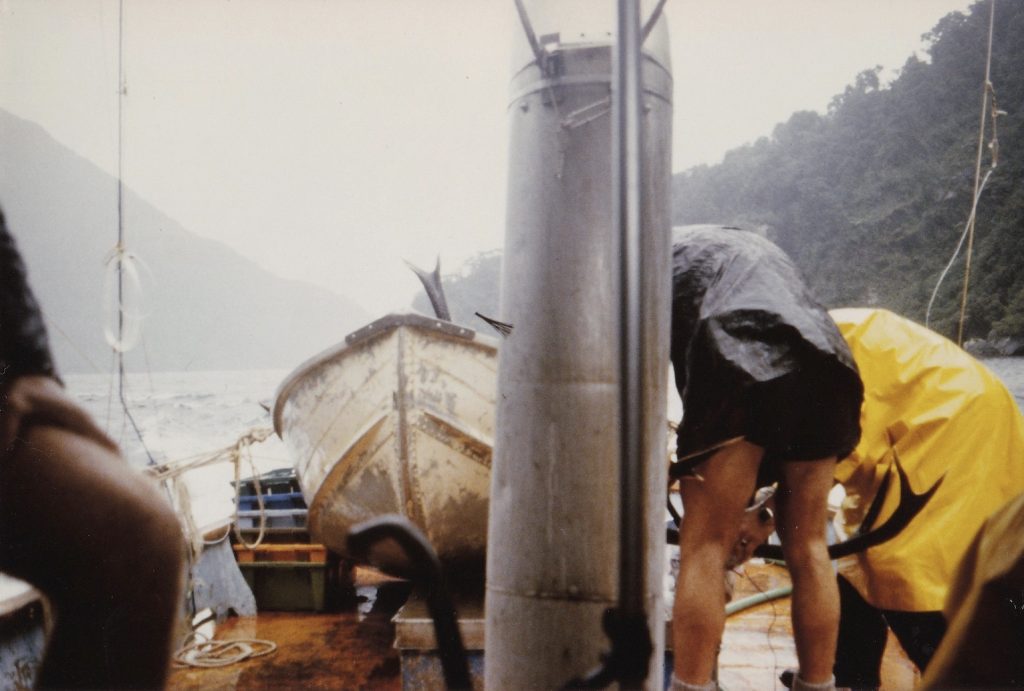
Back on the boat, we had driving rain heading out of George Sound and a rough swell all the way back to Milford. Once we were into the calm, Terry cooked up half a dozen crays and found some beers in the chiller, so a top way to finish a great trip.
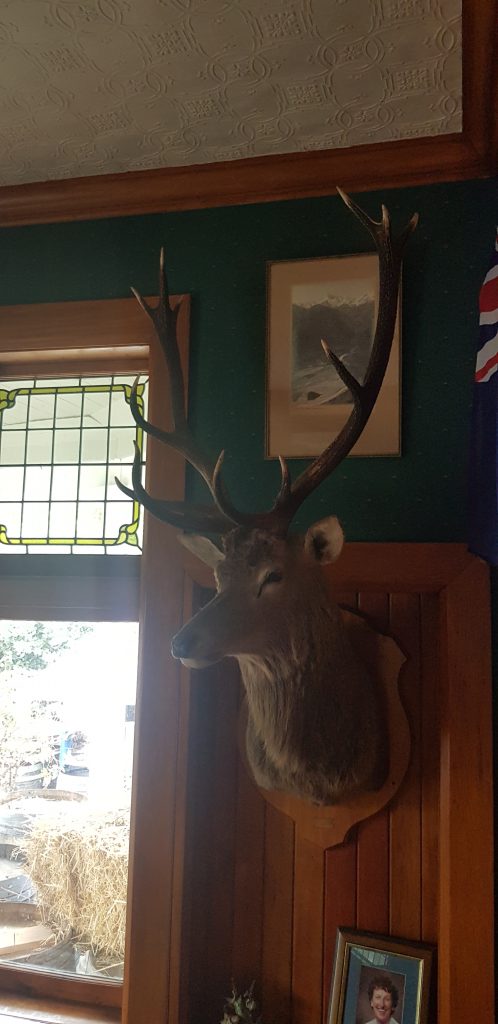
I ended up getting Max to mount the trophy, and whilst it’s not a great head, it has great memories.
Cheers. K Frankum
Grandad
Tramping up through the dry, swirling tussocks, past the old skeleton tree, I was the happiest young fella in Hawke’s Bay. I had sweat on my brow and the pack was heavy, but I couldn’t have cared less.
It was April, 1986 and I was following two chaps up the track. One was a gnarly old character with a BRNO 7×57 slung over his shoulder. He kept a steady pace with a crooked smile on his face, was sharp of wit and more wily than most in the ways of the bush. The other was about my age, fit as a fiddle, and already more knowledgeable at hunting than I could ever hope to be.
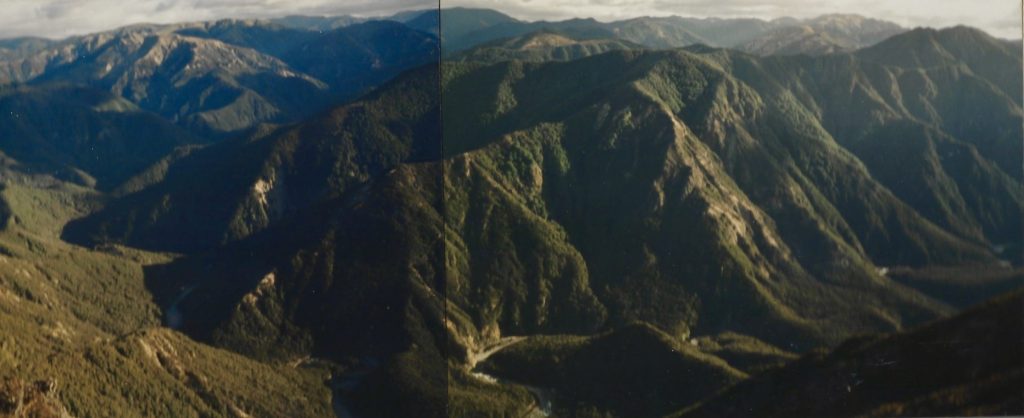
Jack Wire stopped to admire the distant Kaweka tops. He pointed across the mighty chasm towards the Kiwi Saddle, and broke into a yarn about his good friend Max, who shot a large boar not far from the Kiwi Saddle Hut. I had stayed at the hut a couple of times already, chasing my tail, but kept this knowledge to myself, as I was very shy, and a bit intimidated by this old bushman.
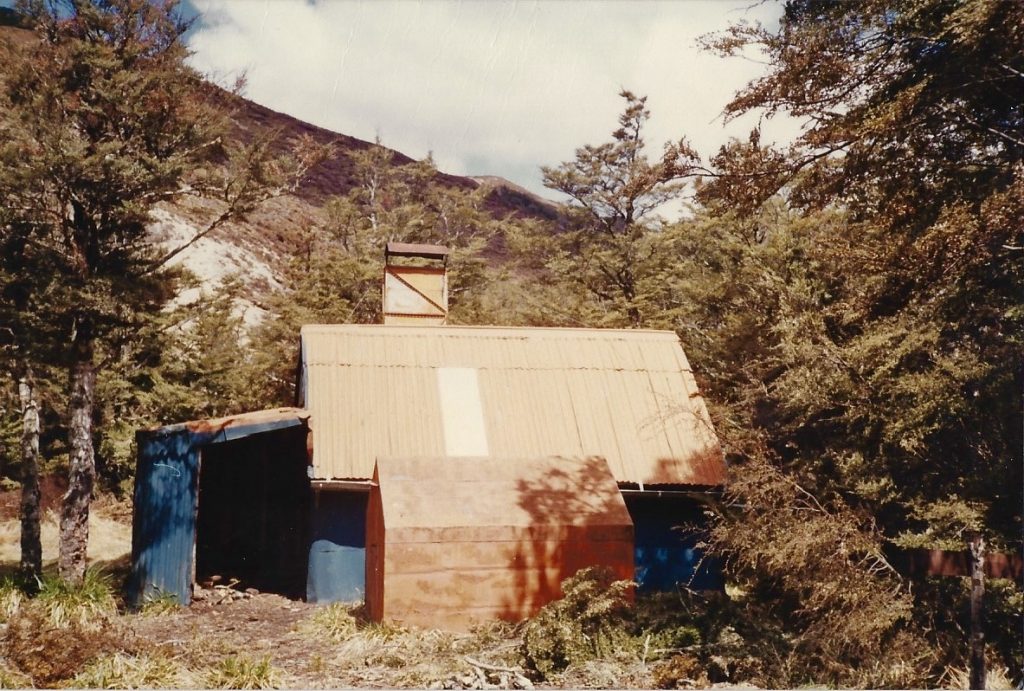
A Sika stag “he-hawed” down in Boyd’s bush, breaking the spell, but reminding us it was the rut. We passed Mount Cameron trig and continued the slog along the edge of the beech before I spied a small, dark tarn, just inside the bush edge. From here we followed the Ngaruroro River faces, popping in and out of the beech trees as we followed the twisting track. The young live wire, Andrew Herries, led the way, as he had already travelled this track many times with ‘Grandad’, as he later referred to him..
After reading about it in one of my growing collection of hunting books, I trudged on, still not quite believing I had been invited on this adventure. I had read the cover off Philip Holden’s classic, ‘Pack & Rifle’, especially the chapter where he nails a trophy Sika stag on this very range that we were now tramping along, albeit a few decades earlier.

We left the stunning views and angled down towards a tight little manuka basin, reaching the hut mid-afternoon. The billy was swung for a well-earned cup of tea before we all set about dragging in some extra firewood, to be cut later with an old-school, two-handed log saw.
Jack’s hut had been built in the late 1960s, further back towards the road, and then shifted to its current spot by Jack, and some other, good keen men. It was hidden down next to a cold running little creek, amongst a sprinkling of old mountain beech. Four sack bunks with a built-up fireplace of earth and stones, a couple of food cupboards to keep the mice out, and a smattering of frying pans and camp ovens, were the basic amenities in this bushman’s hut. With the fire crackling, there was no better place to be in foul weather, when the wind blew thick snow from the south.
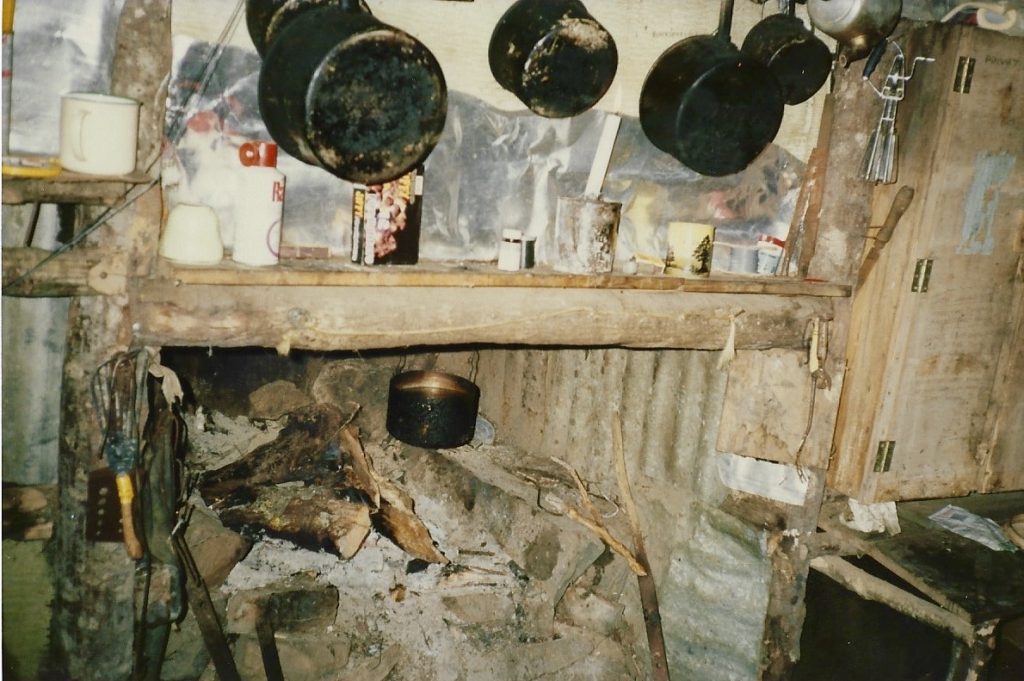
Jack knew this Sika hunting country like the back of his hand, having spent most of his life hunting the surrounding high country, including a stint working at Ngamatea. He was known as an expert bushman, with a passion for building little bush huts that stood for many years, while also being a more than handy gunsmith. He was a cunning old fox, not wanting the young bucks scenting up his cherished local spots, that he had spent years getting to know himself. He told us to pack our gear and go explore the Raoraoroa Stream, where surprise, surprise he had built another hut!
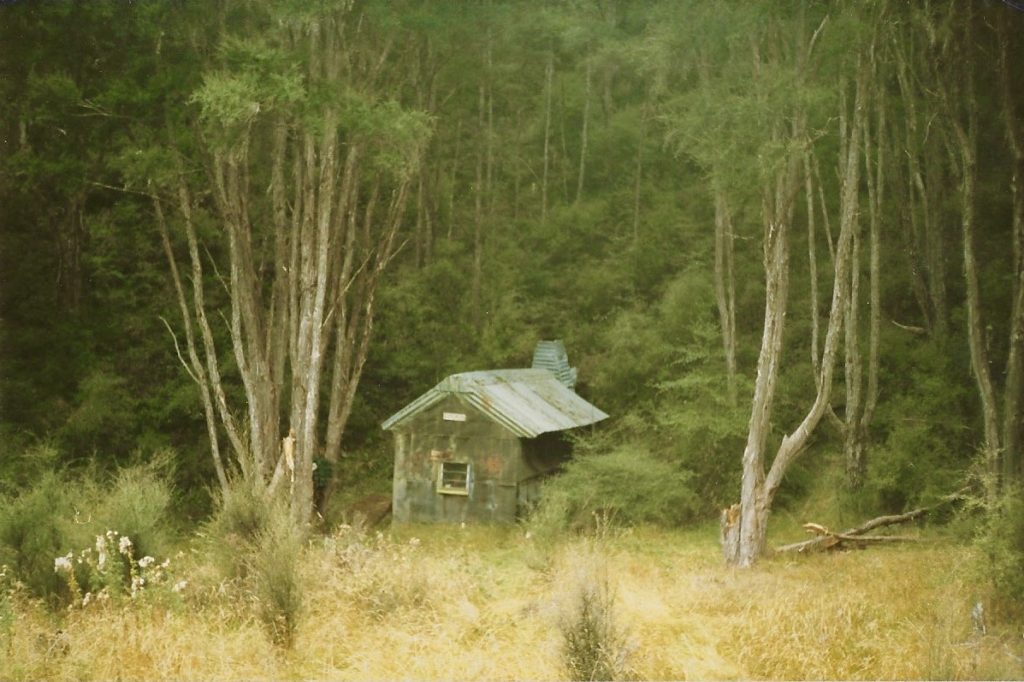
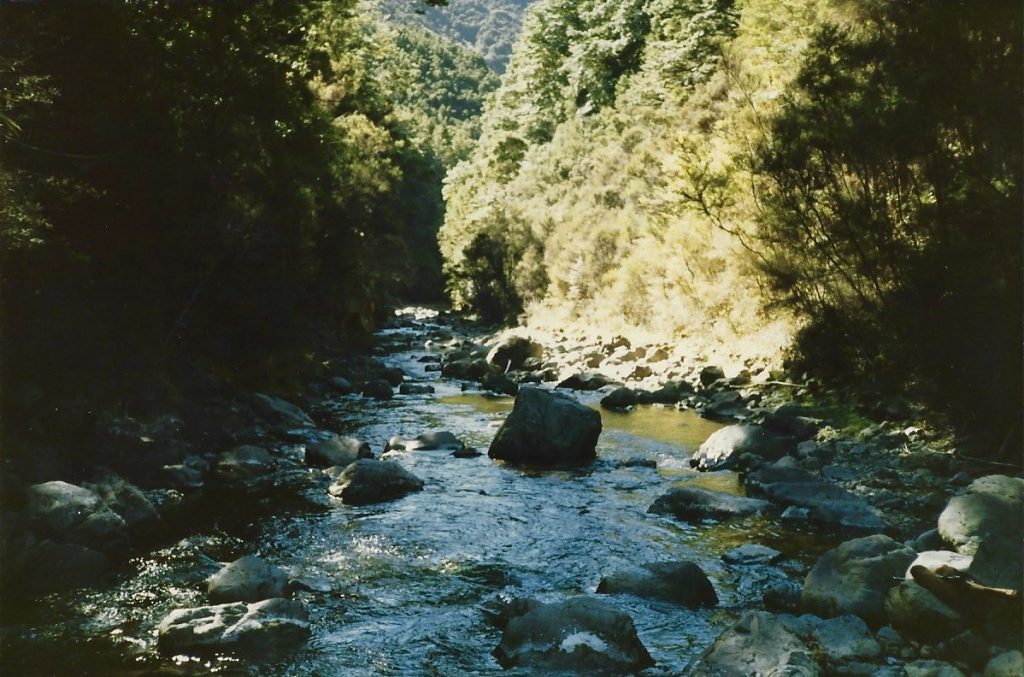
Early next morning, with Andrew leading the way, we left camp. As Andrew had been to the Got Hut previously, I just tagged along wide-eyed, taking it all in. The Got Hut is a really interesting place, seldom visited even back in ‘86. The stream is a tributary of the mighty Ngaruroro River, and once you drop down hundreds of feet through scrub and claypans from Jack’s Hut, it becomes a wet boot country. Jack and his sidekicks started building the Got Hut during November, 1970, after an initial airdrop by Cessna from Bridge Pa. They completed the build towards the end of June the same year. Only those in the know could spot the old tree that signalled the secret turn off to find the Got Hut. Sadly, on my last visit in 2019, the old hut was no longer habitable…
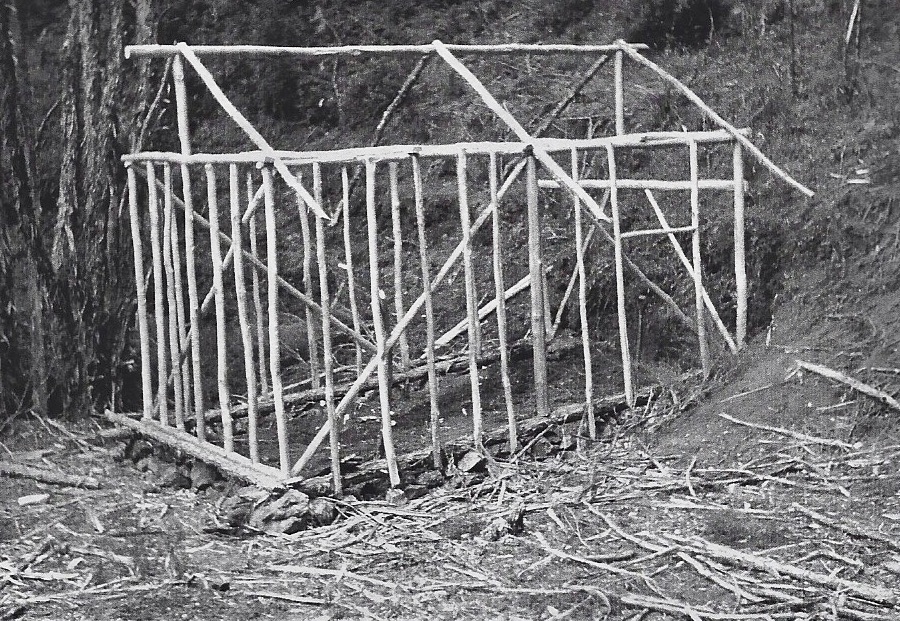
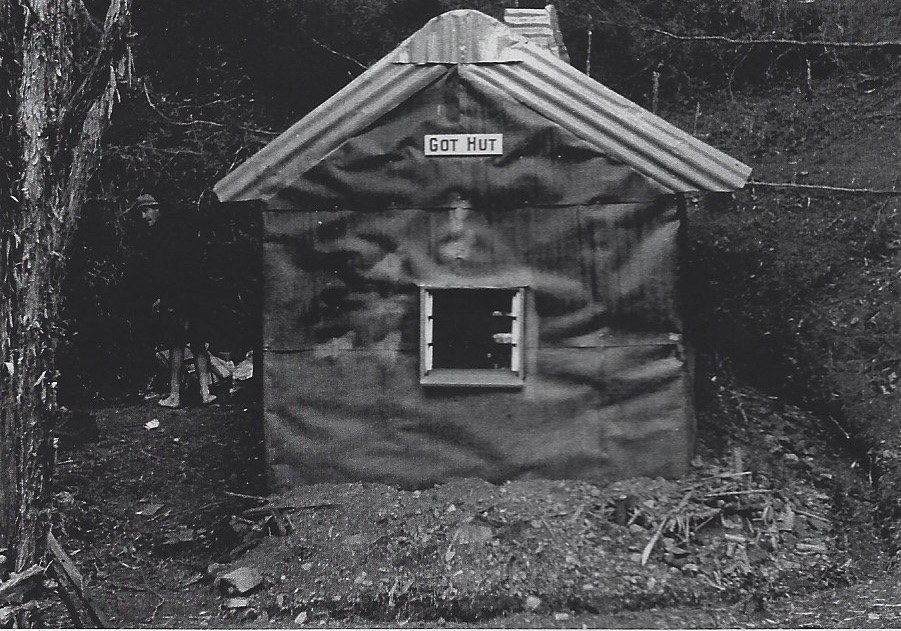
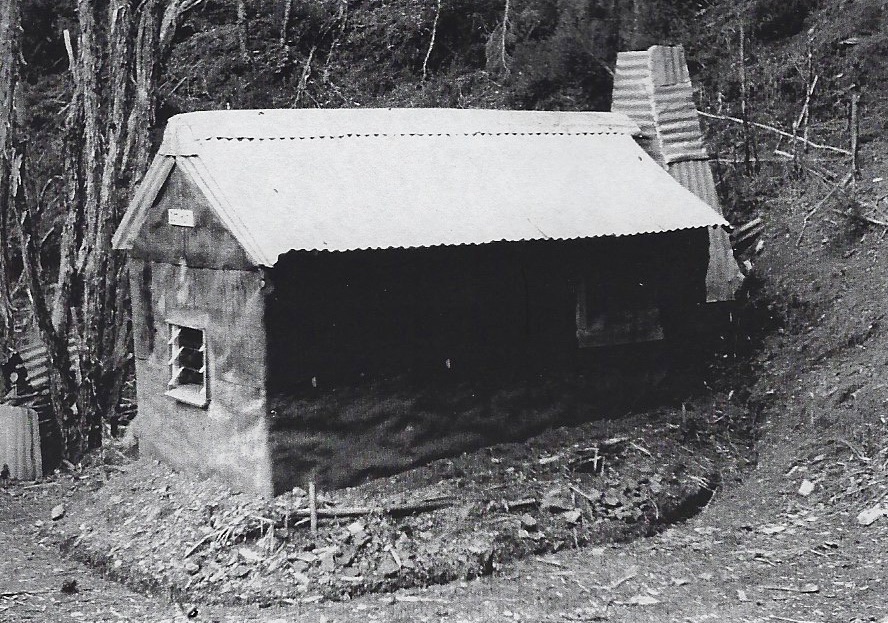
Andrew & I both stalked around for a couple of days without success. Being a narrow gully system, the stags don’t play the game when the wind owns you in the Got, as it always seems to be blowing up your arse!
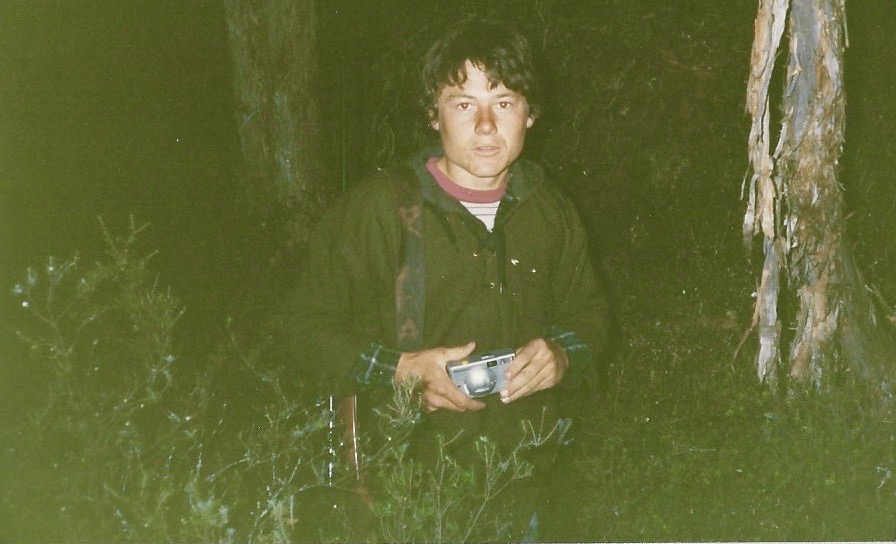
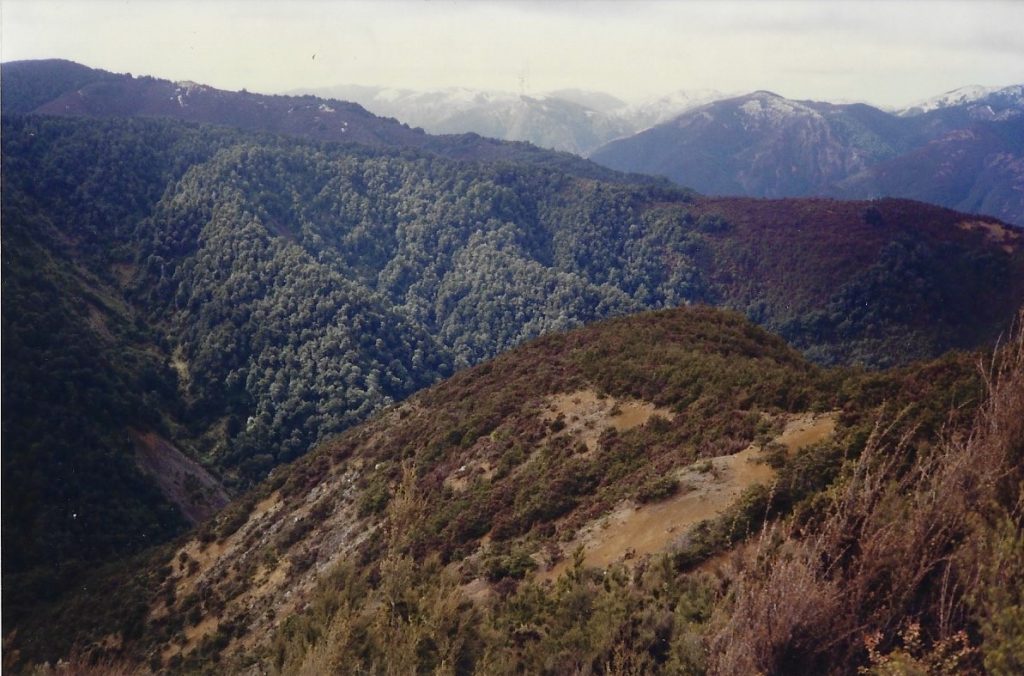
The ‘Got’ became a favourite winter hunting spot for me, that only a selected few were to visit. Once you had been there, you became an honorary ‘Gotman’ for the rest of your days, and you greeted another recipient with a hearty pirate call, “Arrrrrrr Gotman!” (Some would say that is a sure sign of spending too much time in the bush.)
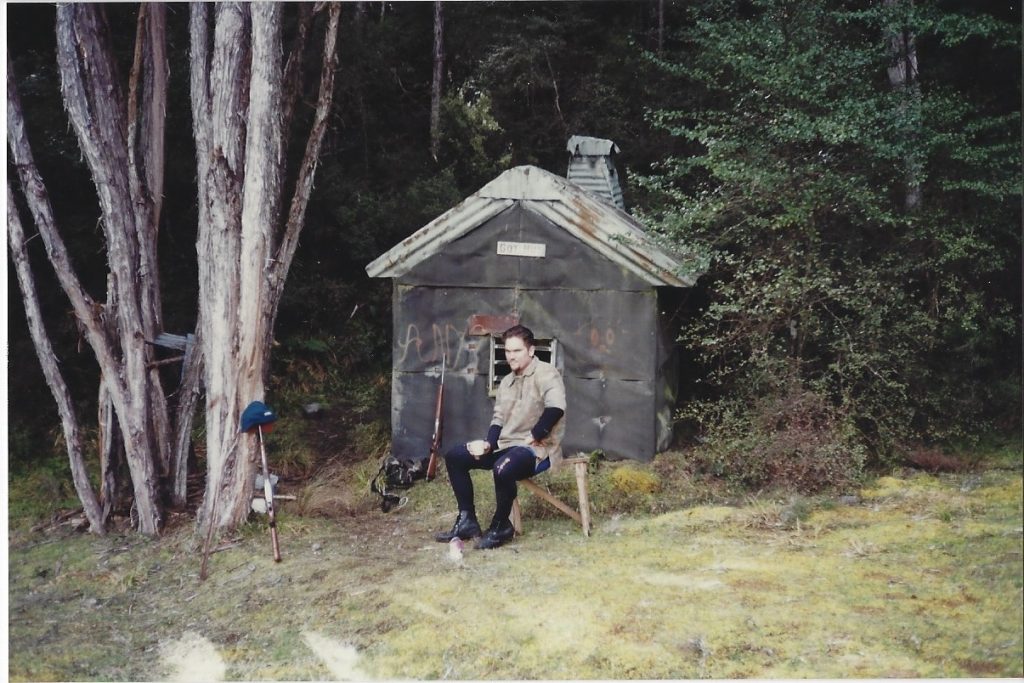
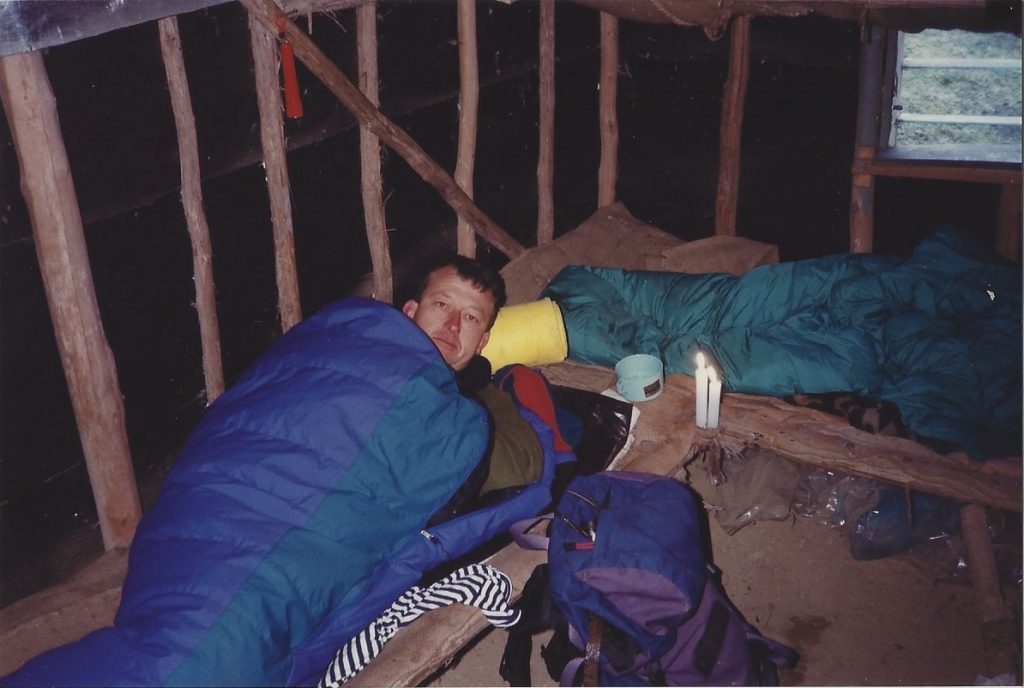
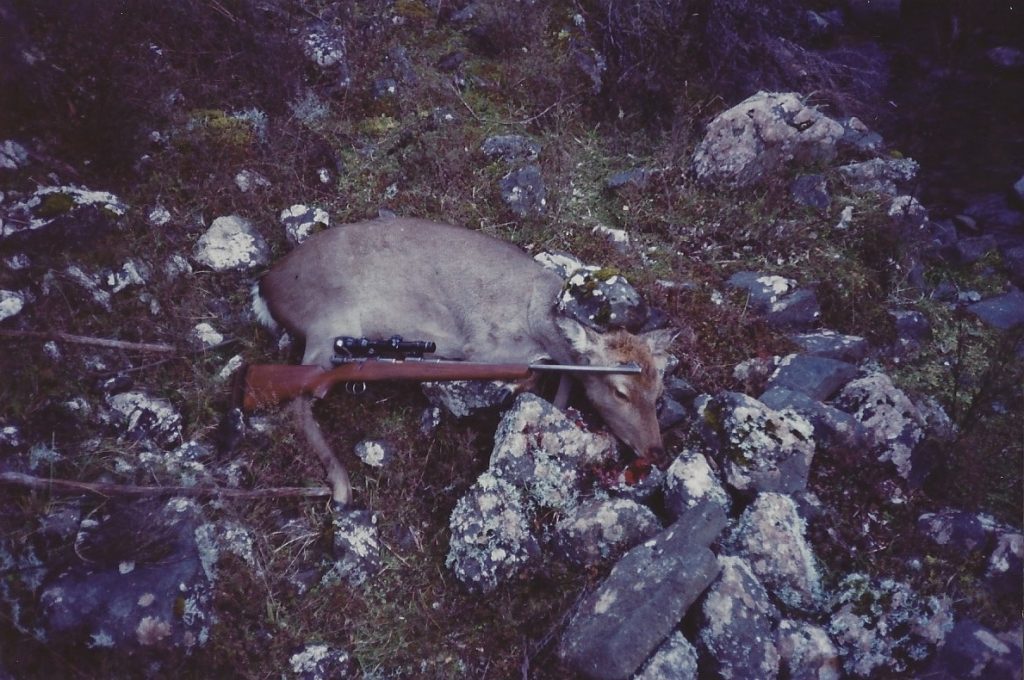
We packed up and farewelled the Got Hut before climbing straight up behind camp, through the old man kanuka, on a lesser-known short track back towards the tops. Jack had been busy while we were away, using all of his Sika hunting experience to put himself into position to have a crack at a single calling stag. On arrival, both Andrew and I were in awe to see a nippon style eight-point sika rack propped up against the hut!
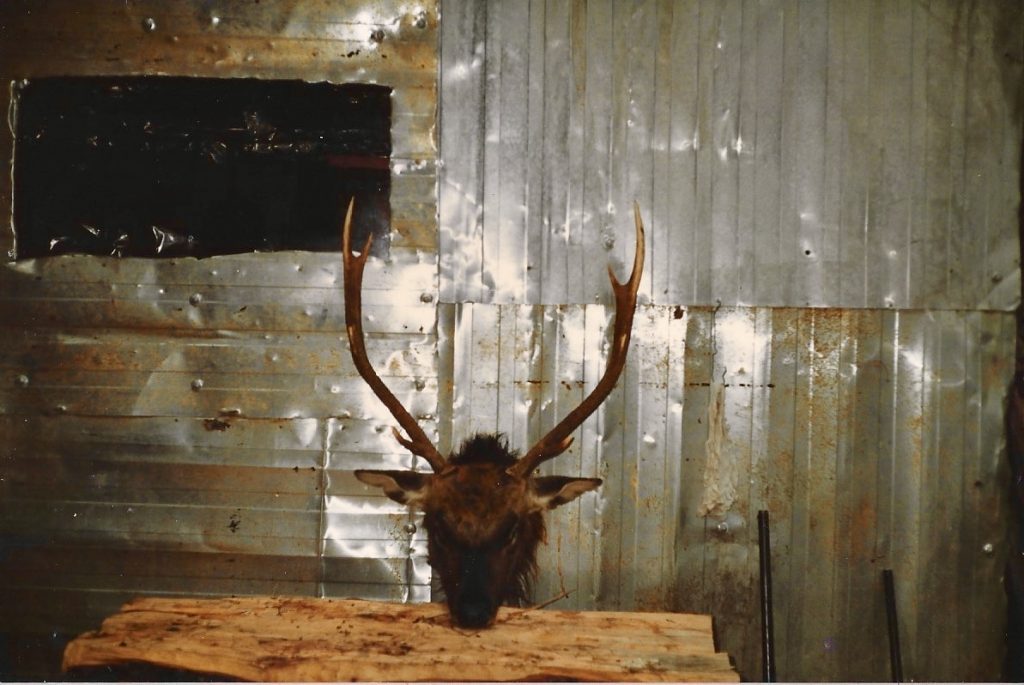
While smoke drifted up the corrugated chimney, Jack recounted the hunt to us that night around the campfire. He’d left the hut early and made his way a couple of miles down into Boyd’s Bush, following one of his many hunting tracks. These he would constantly upgrade with his sharp sickle, slicing through the thick bush lawyer, and anything else that got in his way, until he reached his chosen spot. After waiting patiently on a more open plateau in the beech forest, a rutting Sika stag had chased a hind within metres of him. He quickly dispatched it with his trusty 7×57, that took no prisoners!
The master had shown the apprentices how things were done. Not one to stand in front of the camera, I had to almost beg Jack to let me take a photo of him with his trophy, which he reluctantly did the next morning. To my knowledge, this could well have been the last eight pointer he shot from his hut…
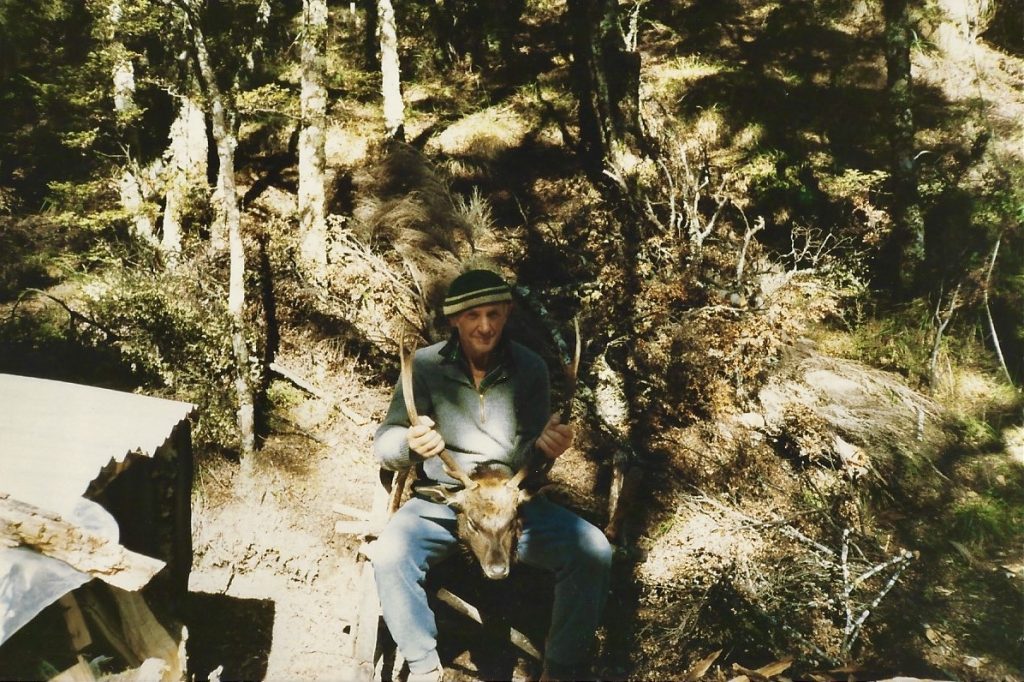
Although I got to enjoy many more adventures with Jack, over time I became more confident with age, in hunting alone in the bush myself. I slowly went further afield, passing through Rabbiters’ Clearing, and on towards the Meat Safe, and the Hogget, identifying the surrounding landmarks until I too, would eventually become self-sufficient.
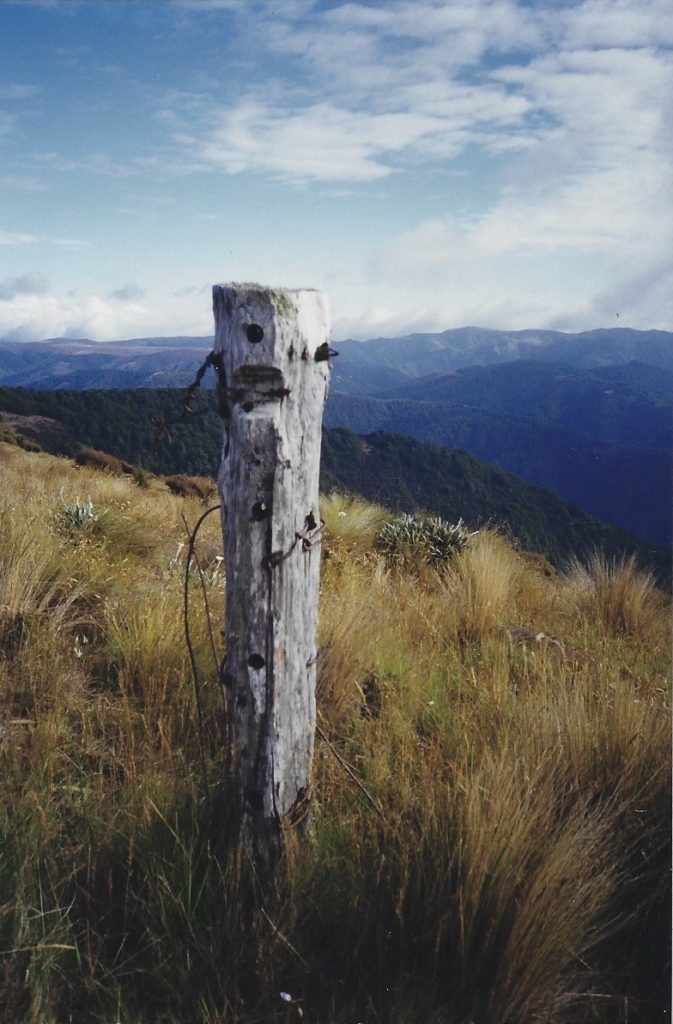
When hunting from his camp, Jack set some tough rules for his band of young hunters to follow. We were not to shoot hinds or velvet stags, and of course, for the next two years, that’s all I would ever run into! Finally, during Labour Weekend of 1988, while sneaking through the beech late one afternoon, I ran into a spiker that was slowly feeding my way. My old Mauser belched flame and I had my first Sika on the deck. Sadly, I had left my small camera on the bunk in the hut, and didn’t get to record this momentous event. However, I did bone out the shoulders and back steaks before carrying the hindquarters back to the hut whole. I was so proud – now I was a Sika hunter!!
Jack often mentioned the written permission he had from the local iwi to build his huts, but eventually, over time the Mt Cameron block was leased to Helisika in the mid-1990s, and as they say, nothing ever stays the same forever…

I was extremely lucky to call Jack a friend for over twenty years, and spent many a lunch hour listening to his yarns over a cup of tea, with him and his good wife, Rose. Jack was a very special character who helped shape guys like me, because he was so generous with his time and wisdom. A group of Jack’s special band of brothers erected a plaque recently overlooking his backyard…
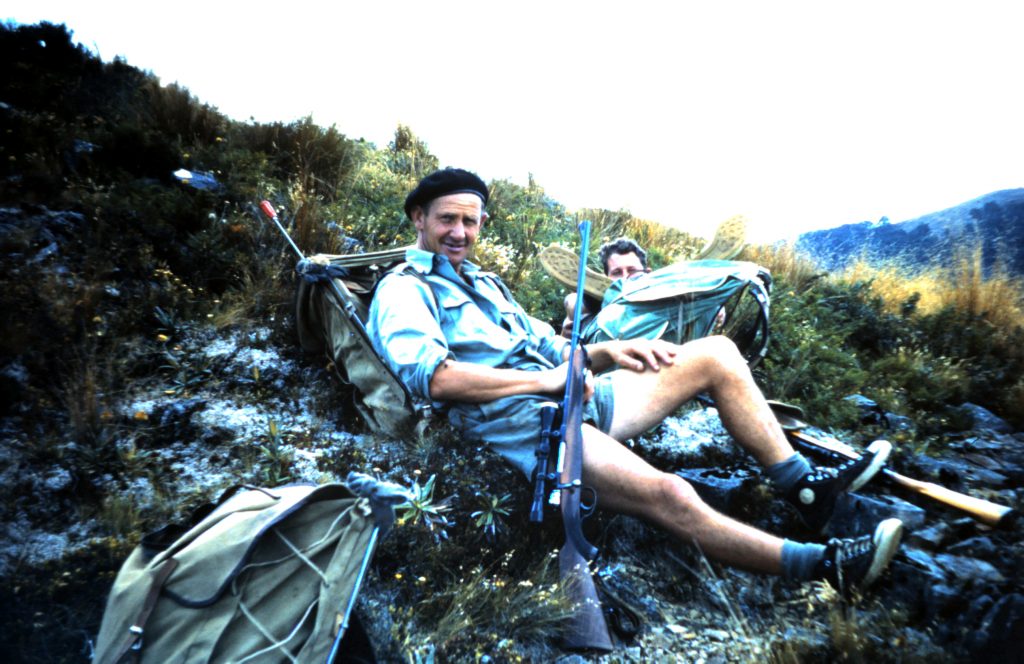
In memory of Jack Wire, 1925-2012.
BRB
Too Easy
The clock ticked slowly while I looked out at the stunning view. The sun was just hitting the eastern faces of the Kaweka main range after one of the longest nights… Emma was going through a marathon far harder than any of the Kaweka challenge races she had faced in the past. In fact, they seemed like a picnic compared to this excursion. Finally, after two long days at Hastings Hospital, our little bundle of joy joined us on April 14th, 2000.
The first three months at home were hell on earth, as The Toot didn’t like sleep, food or anything else. How something so cute could keep us sleep deprived for so long, I will never know.
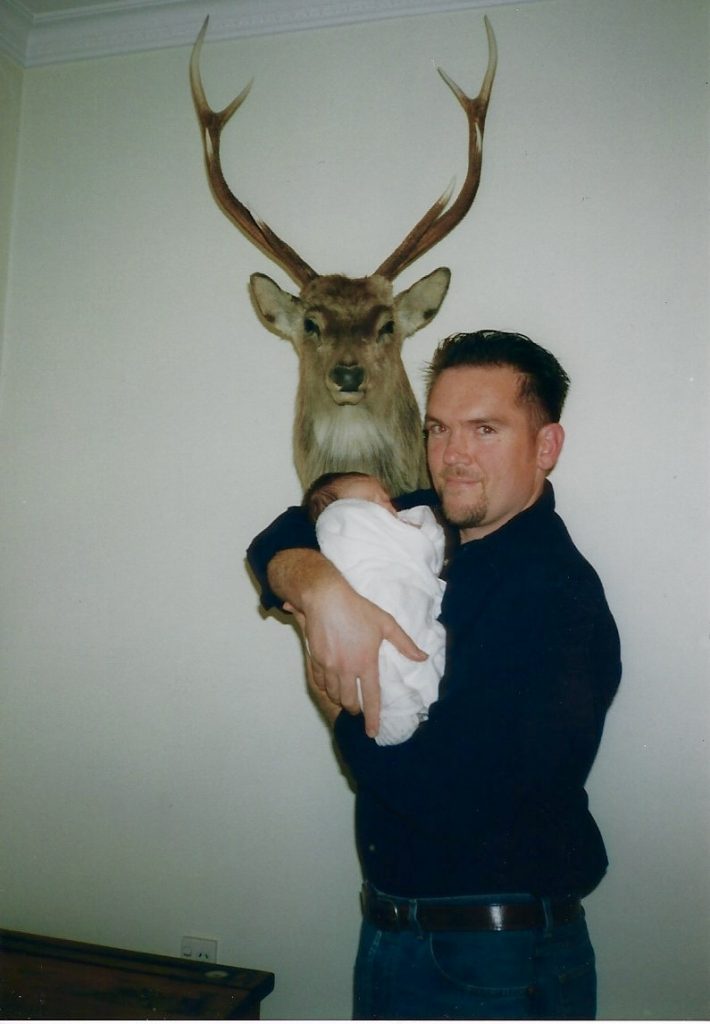
Eventually, things clicked into gear and in September, 2000, I got the call to process a cattle beast on an inland station on which we were fortunate to hunt Sika. Emma was desperate to escape and bring Isabella on her first camping trip.
Surrounded by the huge 1920s shearing shed and classic shearers quarters, the cookhouse had a cosy fire and was more than adequate to house our team, allowing us both to be back in our happy place…
With Uncle Blue alongside as the meat packer, and myself doing the bulk of the butchering, we never knew what we would process until we turned up. Often it was a beast that didn’t make the trip to the freezing works, but was ideal to feed the station staff.
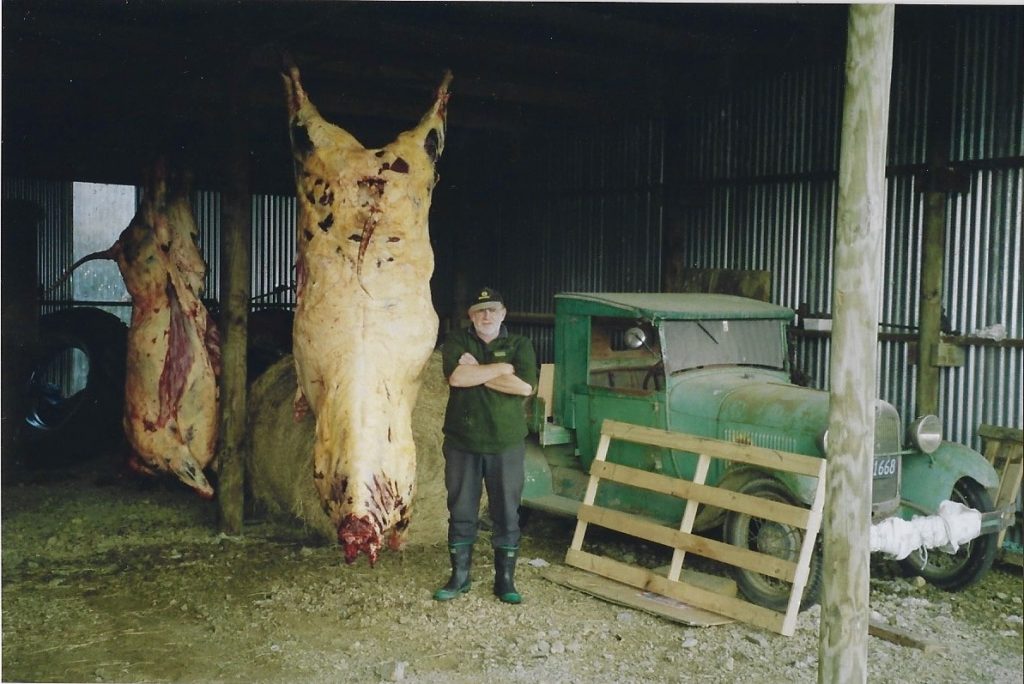
A brisk Saturday morning had us busting beef to stay warm as the sun rose. Normal duties continued until smoko, when the Boss arrived to inspect progress. It was standard fare for me to keep aside the tail and eye fillets each year, as the Boss’s perk, and I never failed him. A real old-school, back countryman of few words, who had shaped the land through an enormous amount of hard work and diligence.
The Boss loved to see his beast hanging on the hook and to inspect it closely. His eyes told me he could almost taste the flavour of the steaks sizzling in the pan.
These trips were never about hunting but we always packed a rifle, just in case a handy meat deer could be harvested before the trip home. The Boss chewed the fat with us, before casually mentioning there were too many deer hammering the grass in the back paddock, and could we do something about it.
Uncle Blue and I exchanged glances, as this had never been offered before, with the normal rules being, ‘hunt well back’.
That afternoon, I suggested to Emma that she should grab her rifle and go harvest an easy deer. It had been a long time between drinks for her. I would hang out with Isabella and keep an eye on our dinner simmering in the camp oven.
The weather gods had other ideas, with light rain and mist rolling in from the tops, blanketing out the surrounding countryside and spoiling any chance of a successful hunt. Emma and Uncle Blue returned a bit damp and empty-handed just after dark. We had a few laughs in the cookhouse that evening, and with the fire well-stoked and happy snuffles coming from the porta-cot, life was good.
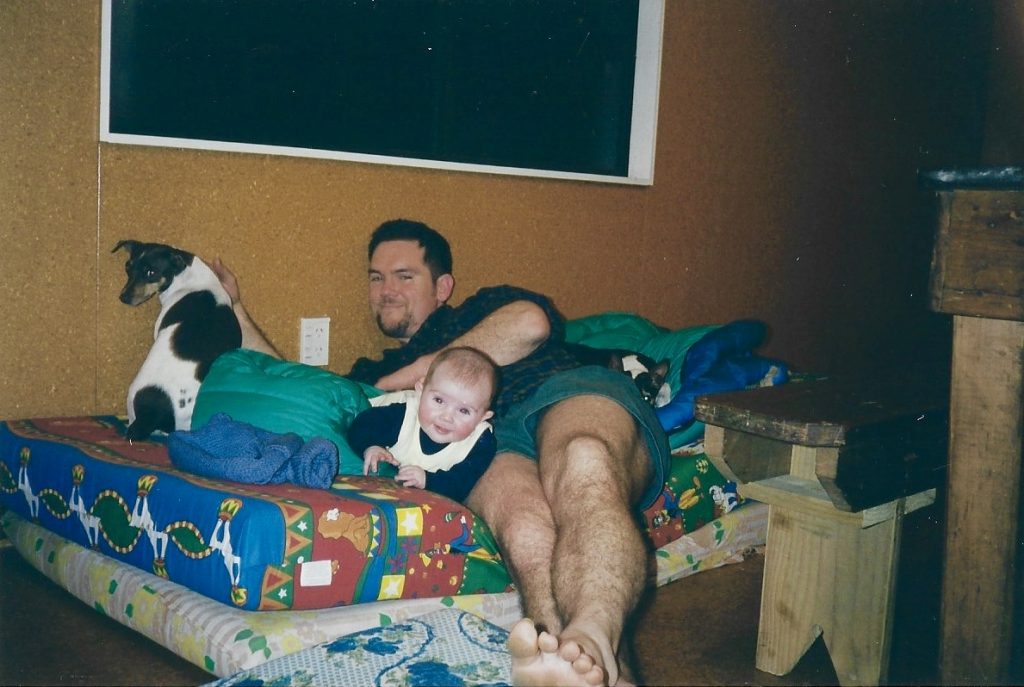
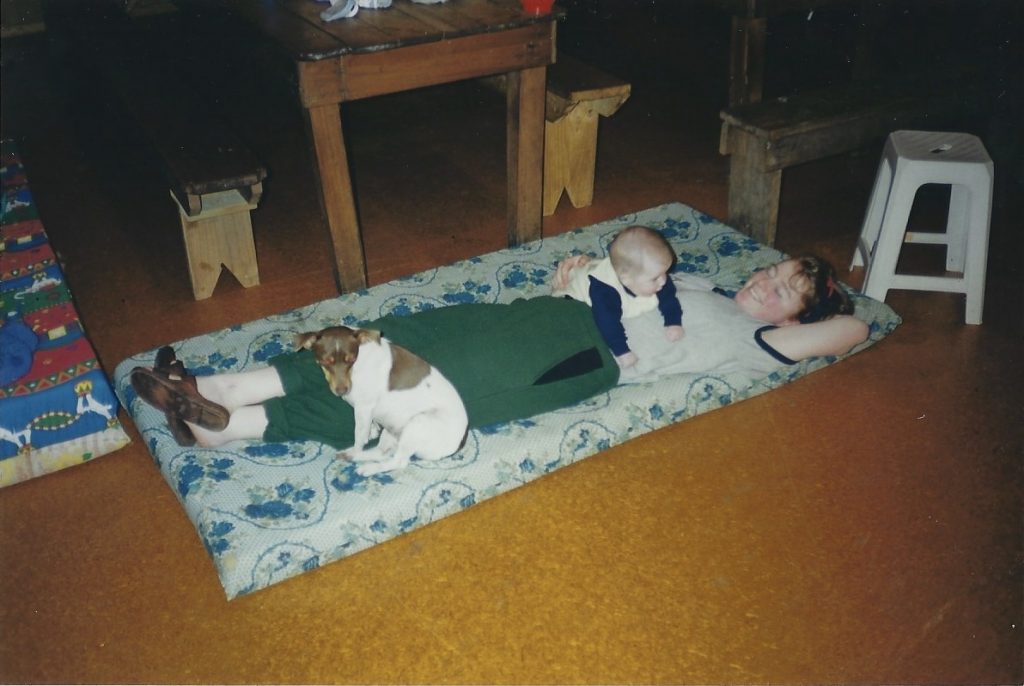
At daybreak, Uncle Blue and I discussed the morning’s options over coffee, before departing the camp and splitting up to cover an area each, but agreeing to be in radio contact if we heard a rifle shot.
Buck, my foxy, lifted his leg on every blade of grass. We slowly wandered up the shingled farm track in a light mist, locating a vantage point where we could stake out the paddocks. The sun was trying to break through as the mist swirled around, while diamond droplets of water dripped off the fence wires. A magpie flew up into an old man macrocarpa tree on this magical morning… and then I quietly swore under my breath. I had spotted the awesome sight of four stags in the far corner of the paddocks!
Wow!! Two of the stags were heads down, stuffing their faces with grass, while a couple of younger beasts had antlers locked together, playfully pushing each other around. I glassed the biggest bodied stag but was disappointed at his mediocre head. Shifting the binoculars to the left… holy shit! This Sika stag had good tops with nice shaped beams to go with it. Funny how things went from a casual walk to serious hunting mode in a flash, as a drum beat loudly in my chest.
My mind was mentally going over the math needed to close the distance so that my Sako carbine would have a chance at a 200-yard shot. This was a new challenge compared to the typical bush stalk. I had to manoeuvre along a fence without much cover and find the right post to shoot off, while keeping the dog in tow. My heart was racing, with a good dose of buck fever kicking in! I had to check myself and calm down, as I knew I would get one shot at this and I didn’t want to stuff it up. I told myself to concentrate on the prize and not to even consider trying to shoot a second stag, or it would all end in disaster.
I crawled through the wet grass for a couple of hundred yards with a dog at my side, before finally easing the rifle on top of a fence post. Breathing harder than I would have liked, but totally focusing on the prize… I squeezed the crisp trigger of the Sako when my stag was perfectly side on! My bullet found its mark and water instantly exploded from his coat. The other deer bolted everywhere!
Three stags effortlessly sprang over the eight wire fence in succession, heading to the safety of the manuka. My stag crashed into it, stretching the tight wires and batons before bouncing back off like a wrestler on the ropes – his morning ended. I climbed over into the paddock feeling mighty pleased with myself and wandered up to the scrub edge to inspect my prize. It was at this point I decided to play a trick on Uncle Blue.
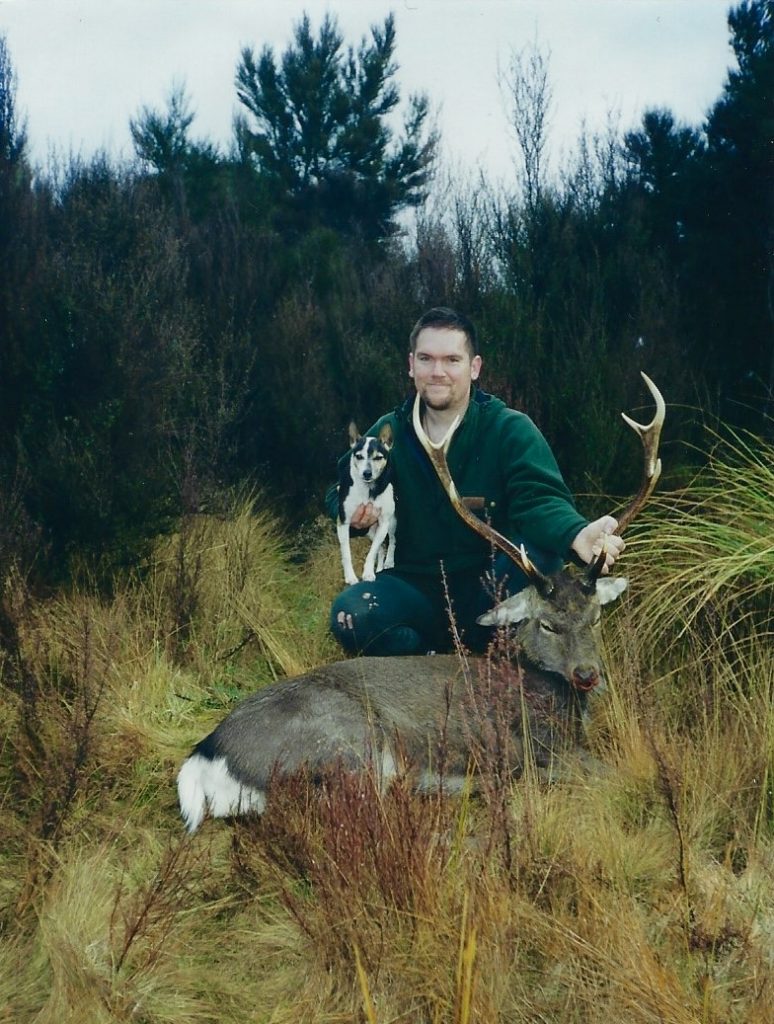
The little handheld radio burst into life and Blue asked what I had shot. Deadpan, I told him it was only a spiker but would he mind coming over to take my picture. Uncle Blue finally arrived and I had the stag slightly facing away, with his head partially hidden under a bit of scrub. We chewed the fat about the morning’s proceedings while he had another smoke before I eventually pulled my camera out, straight-faced. Finally, I dragged the stag’s head out. The look on Uncle Blue’s face was priceless, almost as good as the profanities he used to describe my good fortune! Later on, he retrieved the pride of the Russian fleet, his classic old 4×4 Lada wagon, backing right up to the stag for the easiest of retrievals.
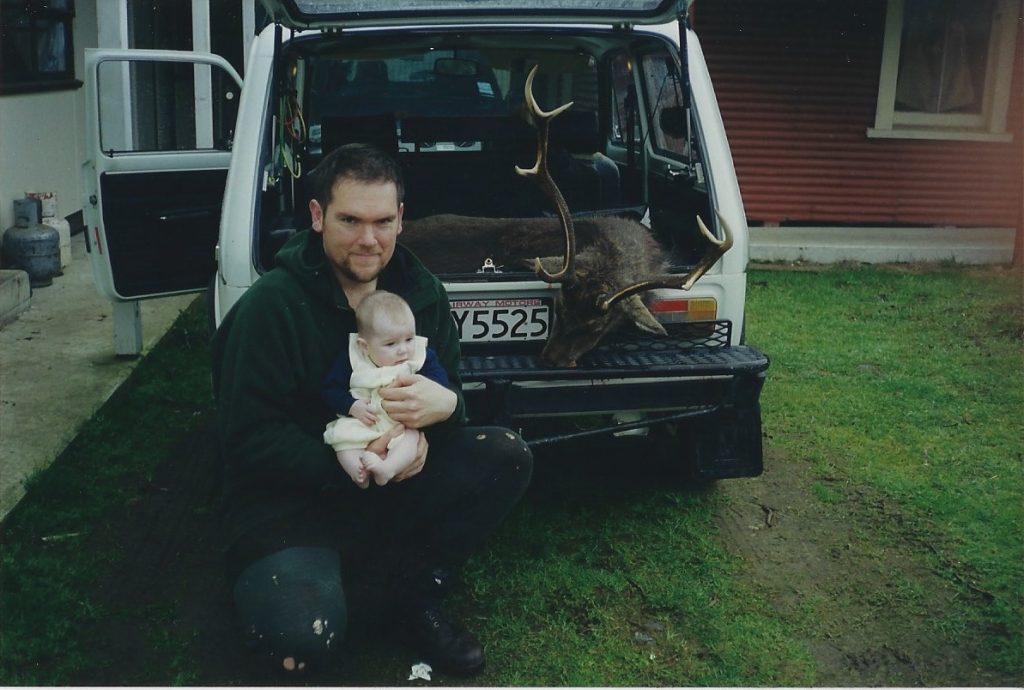
Back at the station, I received some dark looks from the young shepherds, with mutterings about their stag…I was soon able to show it off to Isabella, who really had no idea what all the fuss was about! Too easy…
BRB
Bring Back Buck
Sneaking around in dense bush spooking sika deer just wasn’t working for me! I had been forced to become a bush hunter after trying the open country during summer/spring hunts with mates who would proudly state, “there’s one’” while looking through their binoculars way up on the Kaweka faces. Being profoundly colourblind, I hadn’t a hope of seeing the reddish-orange coats of the sika deer in summer, and gave up in disgust, as a bad idea!! I decided if I was to have success, I would need to get close and learn the art of bush stalking!
What sounded like a brilliant idea at the time proved to be harder than I thought. I would play rugby for my club team, Havelock North, on Saturdays, and then take my battered body hunting on Sundays sneaking around in the Ruahines, or the Kawekas, covering some neat country…
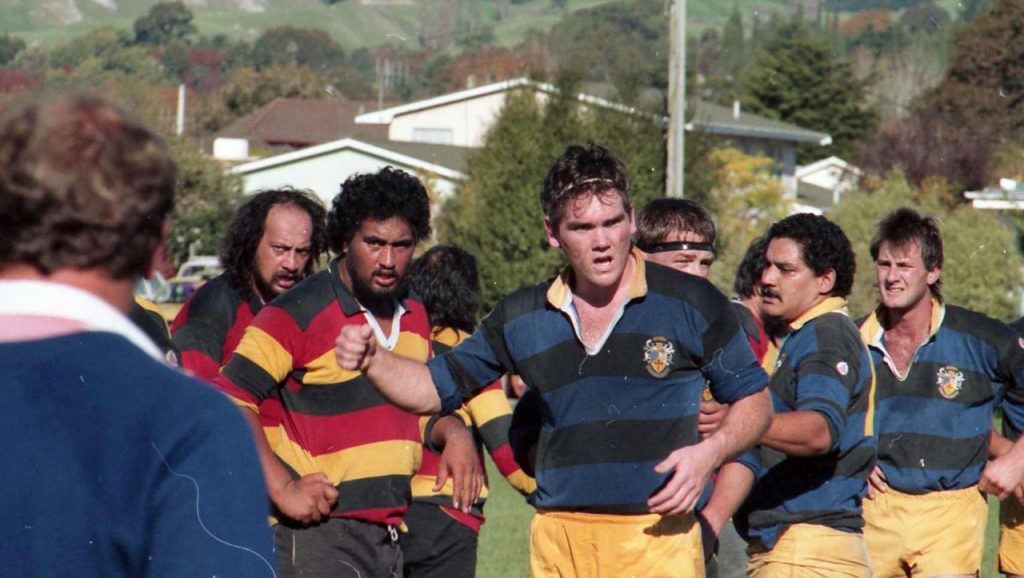
This continued for several years and to be perfectly honest I wasn’t much good at either. I absolutely loved running out to do battle with my mates every weekend on the rugby field but my heart was in the bush. I decided if I was to become any good at this hunting caper, I had to devote more time learning the craft, so at the ripe old age of 25 I retired from the game…
Sika lived in the forest and I was getting bloody good at spooking them as I snuck around trying my best to catch one out! This just wasn’t working, so the next big idea was to get me a hunting dog.
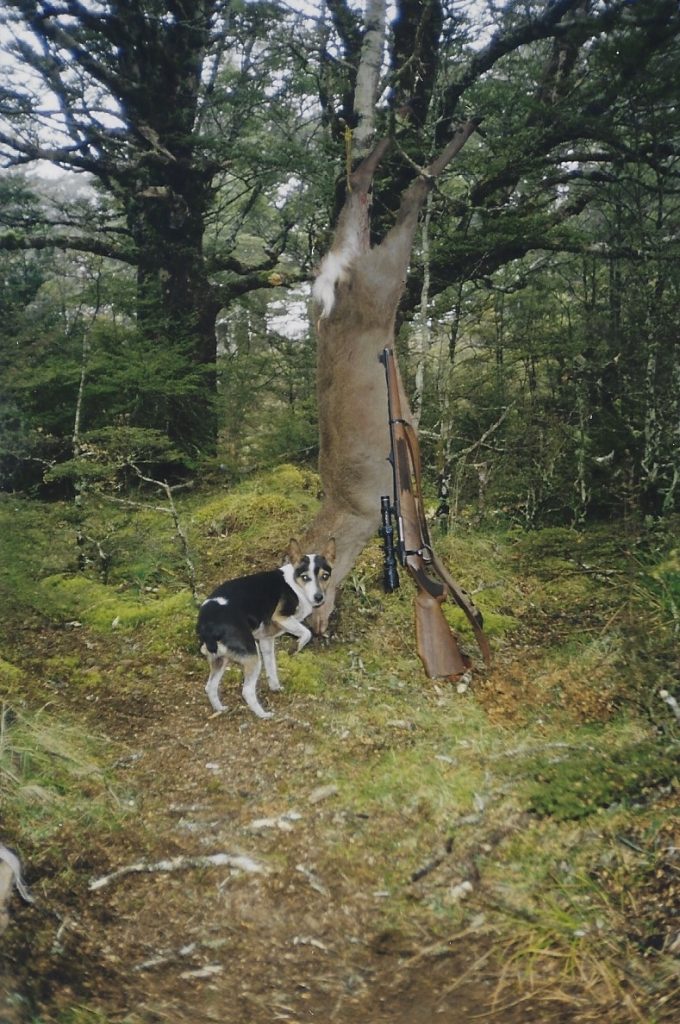
I had read about guys using fox terriers in the Kawekas, and had even seen one on the cover of an old OutDoor magazine that looked cool, a hunter posing with a red stag and a foxy dog!
What did I know about dogs? Next to nothing, as growing up, we never had a dog as a family pet! Although I had purchased one other dog before this, (that’s another tale) I did everything wrong from the start, and should have asked for advice instead of rushing in and buying the first bargain that I tripped over!!
From memory a friend suggested I check out a litter of foxies in Hastings that was going cheap! It was a massive rookie mistake not being able to view both parents! Buck turned out to be a six fingered dog, owing to extra dew claws, while his hind quarters were not too flash either! I parted with my cash and took my little bundle of hunting dog home!
I needed a name for a real hunting dog that would command respect! My mind drifted back to June 14th, 1987 on the embankment at Ballymore Stadium! I was with a bunch of other beer-fuelled Kiwis as we watched the All Blacks dismantle Wales by 49 points to 6, on their way to World Cup glory… But the single moment that stuck in the mind from that game, was the fight that broke out between the two forward packs. All Black legend Buck Shelford knocked out Huw Richards in the ensuing brawl, amid the loud roar from the drunken kiwis on the bank! The sniggers that reverberated around the hills must have been as loud as the roar of a stag, when other hunters witnessed Buck and I leaving a car park together on another mission!
A 6 foot 4 inch giant with a tiny little miniature foxy in tow, striding off into the hills! My theory was simple, all I had to do was put the dog in a position to take advantage of the wind and learn how to read Buck’s body language! This worked to some degree. I would sit happily in a gully watching for all I was worth, keeping my little mate in close using that super nose that all dogs possess!
This turned into a relationship where we started to score about half the time when we hunted together. Back in the eighteen hundreds, fox terriers were bred primarily as a small weapon to enter a fox’s den and chase them out! They developed to be great on rats and possums but can get turbocharged with excitement and are bloody hard to control once that red mist takes over!
Buck became a wicked, loyal little mate who lived for hunting as much as I did. However, one of his biggest failings was his lack of size, along with any decent hair cover on his chest, that would get scratched to bits in the tough environment. He had a hell of a ticker though and walked all the way from Clements Road near Taupo back through the Kawakas and over the main range more than once…

One particular morning I sat out from camp sipping on my tin mug of coffee with the little transistor radio going. I was listening to Jonah Lomu smash England at the 1999 Rugby World Cup while the sun came up in the eastern sky. Once the game was in the bag, Buck & I headed off for a hunt and soon entered the beech forest for a glorious morning of bush hunting. We hadn’t stalked far before his little nose started to work! I peered hard to find what he knew was there, when a slight movement at 50 yards showed an ear flicker! A stag was looking hard our way, and all I could make out was his head and antlers, with those ears working like radar detectors as his nose quivered, sucking in the air. The stag’s body was covered by low scrub so I carefully took aim below his chin at the base of his neck. Buck stood just to my side, frozen like a rock…
Boom, went my fully wooded Sako 7mm08 carbine, sending the 140g projectile his way, in a small cloud of smoke! Now, under normal circumstances, this would result in a good deer to harvest and pack back to camp. I wandered over confidant of my shot expecting to find a dead deer! I got to the spot to find nothing, no sign of blood and the dog was missing! Next minute, down the ridge, I could hear Buck giving his foxy yap as he chased something. This is never a good sign. The yapping soon stopped and became a bark as he bailed something. I ran for all I was worth, down through the forest dodging trees, but closing the gap before bursting onto the scene. The dog was 10 feet off a weary-looking stag, who was sizing up the little dog with evil intent in his eyes!
I tried to call the dog off, not wanting to risk hitting Buck or deafen him more than he needed. However, the bloody stag turned and high tailed it down the ridge into thicker undergrowth!!
Buck was soon back on the trail like a pig dog, before another bail took place and again, I finally got there but couldn’t place a shot in the thick undergrowth. This wasn’t going to plan, and I was getting a bit pissed off at this stage with all the running. I managed to yell at the dog and call him in. With Buck secured to a rope, I took stock of the situation and caught my breath. It was obvious the stag wasn’t too badly hurt so I made the call to sit down for 15 minutes and hope he might either fall over or lie down and seize up.
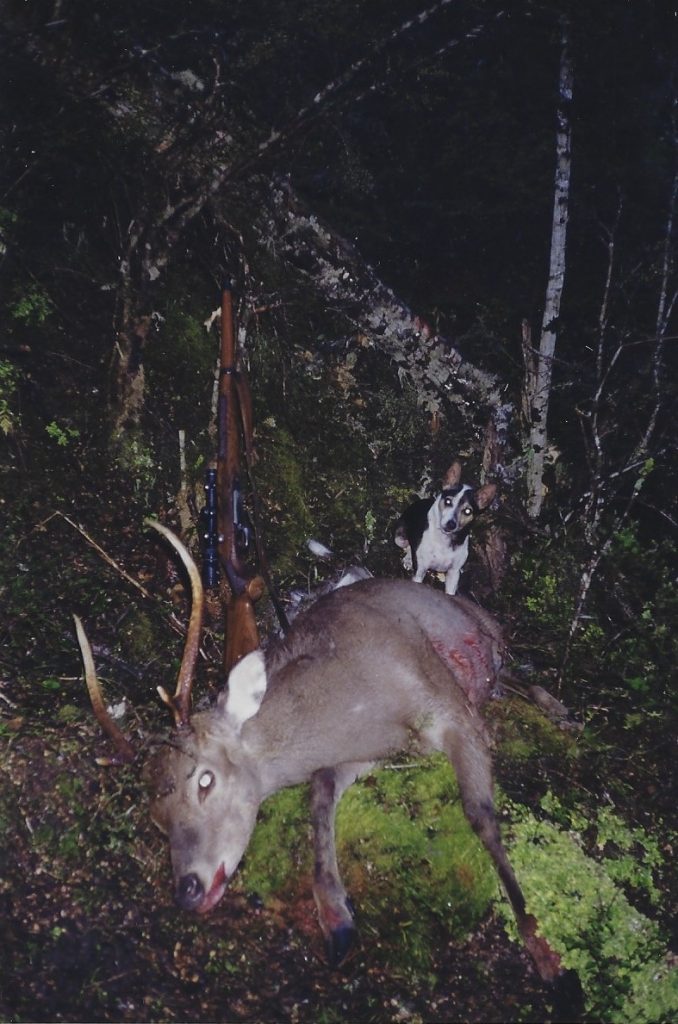
Finally, we snuck down towards the lower end of the ridge which dropped into an open creek. Buck tracked him up the twisting stream for about 50 yards, with his little nose firmly working overtime as he ground scented after the animal.
We caught up with him around a bend and I quickly put him out of his misery with a shot to the engine room as he was about to depart again!! Without the little hunter, I wouldn’t have found that stag in a million years. Curiously the stag didn’t have any visible wound from the first shot!! To this day I am convinced the stag had a concussion from the first bullet exploding on small branches in front of his face, and was really confused by the little yapping dog after him.
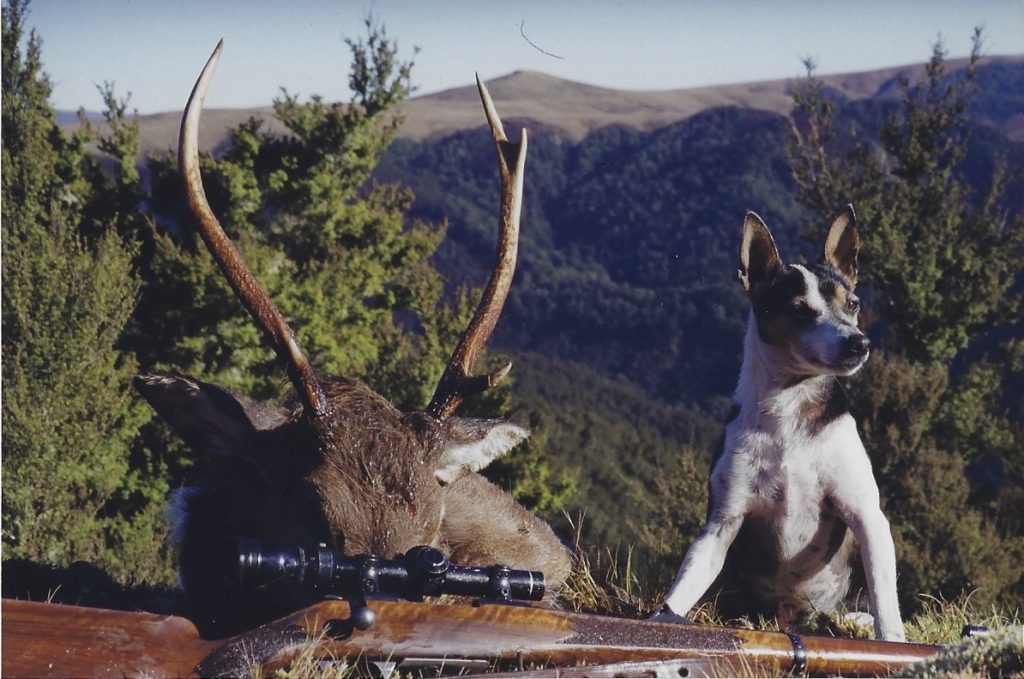
Buck and I had many years of adventures together and I have lost count of how many deer we accounted for. I would recommend any young hunter, desperate for their first hound, to consider a fox terrier. Small, compact and very loyal, and with today’s electronic training collars, they can be controlled as well as any of the expensive pointer breeds.
BRB
Stag down
1995 was a big year! I got married to Little Red in January, then she left me in April for police college! The year before, I had scored access to a massive block of native bush that was home to Sika deer. We had started to explore the block that summer. Because of tree milling years before, the regrowth and bush lawyer were on another level. The place really was a jungle with the only tracks almost overgrown. The skid sites were covered with old piles of hand-split batons that had been left to rot. Many weekends spent with hand saws and secateurs became the norm, as Emma and I cut in towards the middle of the block where I imagined the deer died of old age!
I had purchased a large black and white photo from Aerial Mapping (based at Bridge Pa) that cost me plenty. I’d hoped it would pay dividends, showing us where some of the better gullies might be, while indicating some long overgrown logging tracks. Our spirits were severely tested in the summer heat. Very little breeze penetrated the walls of scrub as we cut through. Often, we would return to camp with blistered hands and scratched legs, feeling like we weren’t getting anywhere fast.
Finally, the hard yards started to pay off. In early March we had a few kilometres of track cut deep into the block. We’d reached some more open red beech, south-facing gullies that promised much. Over time I hauled in a couple of small barrels and slowly filled these with supplies for a fly camp during the coming roar. On one such weekend, while climbing out of a small muddy gut and concentrating on my footing, I spooked a large stag who bolted away around the face through the pepperwoods! He was too fast for a shot, and I was left disbelieving at the glimpse of his long white antlers!!
Being early March he must have been right at the stage of stripping his velvet and hadn’t had time to stain them up before I rudely disturbed him. I now believe they go from velvet to stripping in a day and then colour up over the next week on the local vegetation. He was close enough, as he crashed away, to show me the biggest Sika rack I had ever seen! I didn’t get much sleep the following nights thinking about him.
The Sika rut really kicks off around mid-April so I set off for a week of solo hunting back into my favourite red beech gullies, while Emma worked hard towards graduation at Police college. I set up my fly camp high above the red beech gullies on a flat bench nestled in amongst the mountain beech. For the first couple of days, I battled the westerly gale that blew nonstop, testing the strength of my Huntech fly to the max! I purposely kept away from the hot spot, not wanting to scent it up, and proceeded to hunt further to the north. Dejected, I returned each day having only spooked the odd deer and getting squealed at in the near gale winds! The third morning rolled around and to my delight, it was cold, still, and frosty!
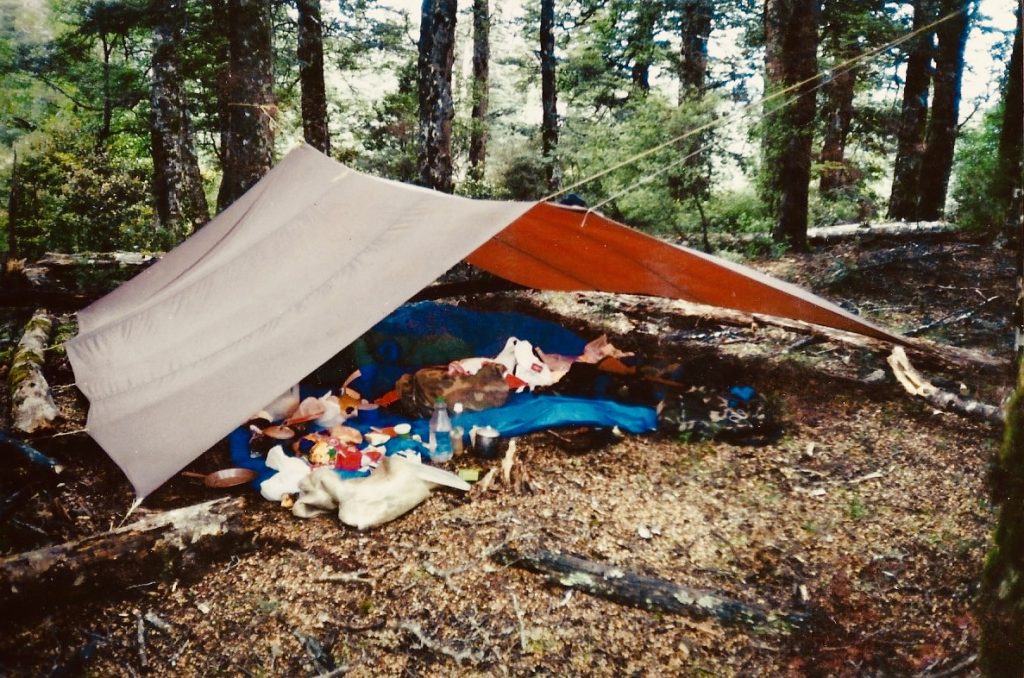
After a couple of hot brews made from the warmth of my sleeping bag, I gathered the gear I required and jammed it all into my polar fleece Huntech day bag. This gear was relatively new to the market back then, and was the bee’s knees!! Polar fleece was changing the hunting world at the time and my mother was very handy with the sewing machine, running up home-crafted jackets! It was the beginning of the end for the old wool Swanndri that had served me so well for over ten years. I had purchased it from one of the local farm outlets for the huge price of $50.00 while still a butcher’s apprentice! That was a lot of money for a lad starting out on $82.50 a week!!
I was soon pushing down my simple hand-cut hunting track in my rubber Bullers towards the hotspot, always hopeful the stags might start roaring! After sneaking down, I had a simple plan. I aimed to sit quietly for as long as it took (all day if necessary) in the hope a stag might pass my way. My previous Sika roars hadn’t produced much luck. I had covered many miles chasing my tail, as the stags would “he-haw” but never where I was. And I couldn’t call a stag in with my red stag imitations. I was seriously limited in experience, and to make matters worse, had missed a lovely 6 pointer the year before (another story).
I sat under the bush canopy peering down the pepperwood-dotted ridge while listening to the sounds of the birds, and the trickle of the creek far below. I was waiting for the sun to poke over the ridge above me and warm up the cold gullies. The odd “he-haw” away in the distance kept my focus and finally, around 9am, something caught my attention across the dark gut to my right!!
A movement amongst the pepperwoods transformed into the shape of a solid deer walking purposefully uphill!! I could see he was a stag from his steady gait, while his dark-stained antlers mostly blended in with the bush… I slowly closed the bolt of the vintage Swedish Mauser that I was cradling, before swinging it towards the moving deer. I found the centre of mass in my little Tasco bush scope and took up the slack on the trigger!
The boom in the gullies must have been very loud, but I don’t remember it as he went down in a heap. In a flash, much to my horror, he began rising to his feet again! I had worked the bolt without realising, and sent round number two his way, again dropping him a second time. He wasn’t quite done yet, so round number 3 was fired for insurance – all in under twenty seconds!
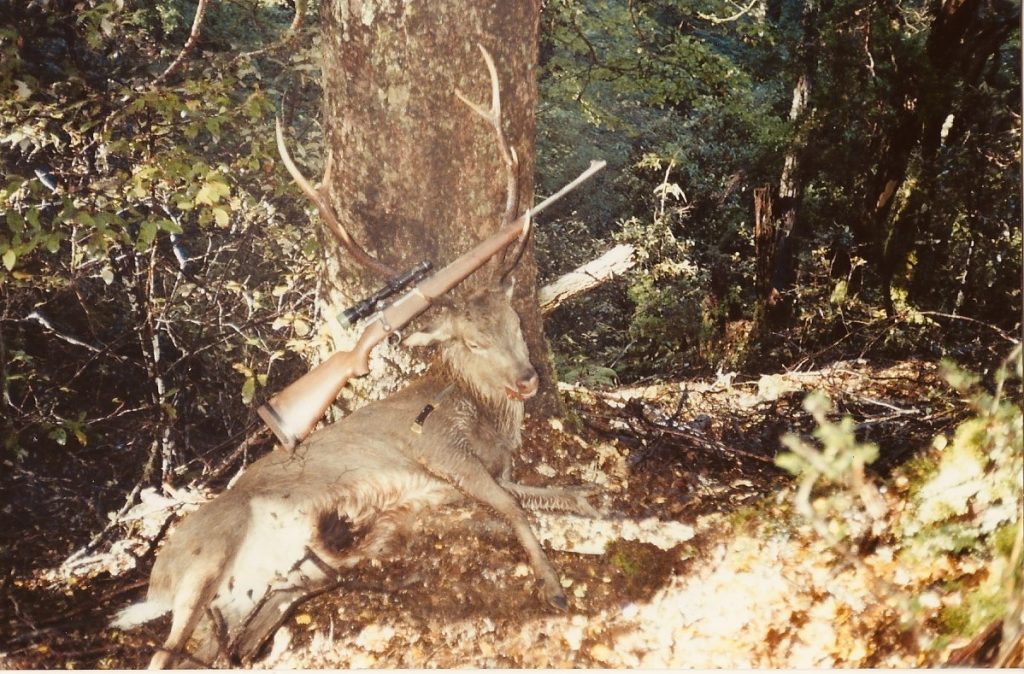
Up until this point, I hadn’t many notches on my belt, with my best Sika being a scrubby little six, along with a handful of hinds, and a spiker thrown in for good measure. I sat there looking across the gut trying to take in what I had just done, with round number 4 locked and loaded just in case… (I think my Carl Gustav Swedish Mauser held about four 139g bullets in the mag).
Although the adrenaline had run its course, my mind was still racing at this turn of events! I had just shot my first rutting stag and had a lot to process! I couldn’t take my eyes off the spot in case he vanished. I finally stood up, grabbed my pack and dropped down a game trail into the gut, crossing through some mud and ferns, before climbing up another steep trail on the other side.
Once you smell a rutting Sika stag it will be with your senses forever – a powerful mixture of bush and wild animal musk. I located him easily enough and just stood there for a moment taking it all in, not yet believing I had finally knocked one over. I had put in years of bush hunting to arrive at this point, with the rutting stags always making a fool of me, as I learned my craft.
His body looked well-conditioned with a glossy coat but his head was slightly twisted, with his rack only showing one side. I mentally counted down from the top, noting 4 strong tines! Just the fact that he had a top was amazing as I hadn’t been able to see that when he was striding up the ridge! I finally grabbed some bone and carefully untwisted his antlers that were stuck in the rich earth to reveal matching tines on the other side! I was truly stunned at this point, not really believing I had finally shot an 8 point Sika stag! This after deer stalking for ten long years, bashing around in the Ruahine bush. Red deer were low in numbers thanks to the helicopter pressure being applied at the time.
This was my holy grail… Sika deer in the bush are the masters of the universe, and I had struggled like crazy, roar after roar, trying to locate them, let alone shoot one. They really were ghosts that I couldn’t locate in their environment. Most trips I would return dejected after being squealed at time and time again…
I remember just sitting down and admiring the stag for quite some time before I realised I had to make some choices! I eventually set up the camera – propped up on the day pack for a little extra height, and clicked off a few lucky shots using the timer before deciding to half cape him out.
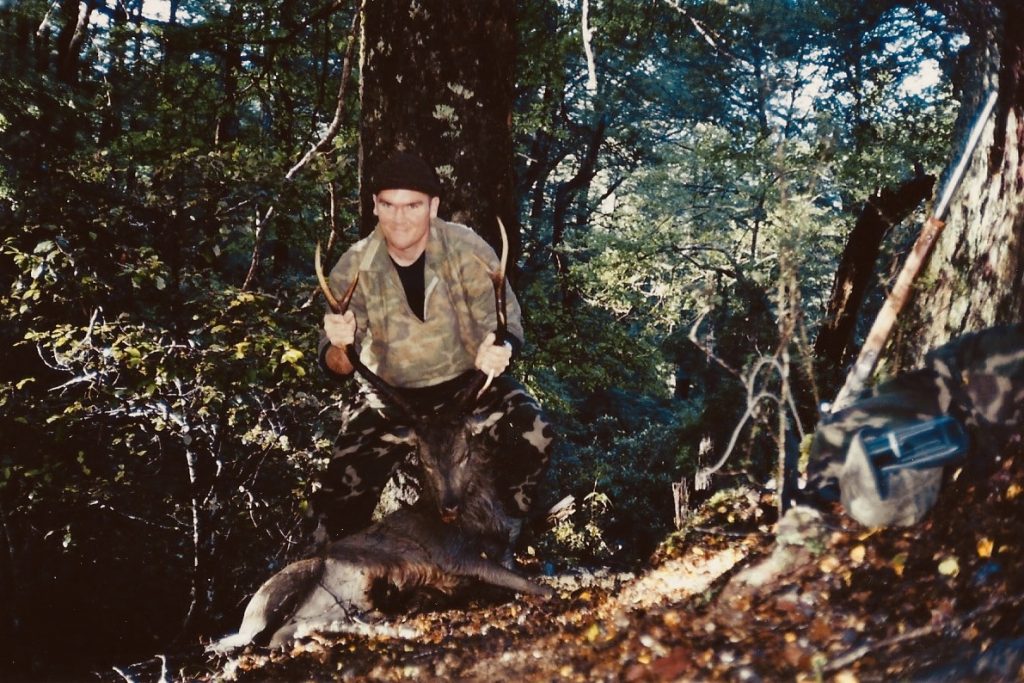
Max Motley, our local taxidermist and my mentor, had drummed into me about taking enough cape off an animal if I ever got lucky on a good stag, so I set to skinning him out with my butchery skills, up to his last joint in his neck. Backsteaks and hindquarters were accounted for, giving me a decent load to take across to my track.
I raced back up to camp, piling everything under the tent fly in my hurry to get going, as I knew I would return for it in 24 hours. I took my empty 90L pack back down to my prize! By now it was around lunchtime and I slogged out under a heavy load before driving like crazy back to Havelock North to Max’s place. Here Max cast his eyes on my trophy and declared him worth mounting, much to my delight. My continual harassment of this master taxidermist had this achieved only a few months later, and he was finally hung with pride on my wall!
Not much later, a wise, old deerstalker expressed to me that I should enjoy the stag for what he was, as I was unlikely to get a better one. Eight point Sika stags are few and far between, and for those interested in the Douglas Score, he measured a respectable 160 (NZ record book standard is 170DS).
BRB


